Welcome to my guest blogging page where you will find guest blogs from other authors, introducing their own work. There are some wonderful people here! And do follow the links to their blogs for more information. If any readers of this page who are also authors would like to appear in An Author’s Mind series, let me know and I’ll send you some questions which will explore how writing works for you. The more, the merrier!
On the blog so far:
Diana Stevan – Sunflowers under Fire
J L Gilliland – The Descent of Lakshmi – Mythic Book 1
Debbie Young – Springtime for Murder
Zara Altair – The Roman Heir
P K Adams – The Greenest Branch
Ali Bacon – In the Blink of an Eye
Rosemary Kind – New York Orphan
Jessie Cahalin – You can’t go it alone
J J Toner – The Gingerbread Spy
Annie Weir – Judith Wants to be your Friend
Denitta Ward – Somewhere Still
Rosalind Winter – Ready, Steady, Dig!
Cath Cole – Home from Home
Tim Walker – Uther’s Destiny
Jane Davis – Smash all the Windows
25th April 2019
One age-old discussion in writing circles is the ‘writing about what you know’ concept. This implies staying within your own experience and many writers immediately bristle, saying ‘No-one wants to hear about my life’. But – as ever – the trick lies in what you make of it. That’s where originality comes in. This month’s author on the blog, Diana Stevan, is a case in point. She has written Sunflowers Under Fire starting with the true facts of her family history. And what a story it has become!

Lizzie: Welcome, Diana!
Diana Stevan: Thank you, Lizzie. And thank you again for doing this.
Lizzie: So could we begin with a brief summary of the story in Sunflowers Under Fire?
Diana: Yes of course. Soon after her husband volunteers for the Tsar’s army, a Ukrainian farm wife and her six children flee from the invading Germans only to face the trials of a refugee camp, typhus, unimaginable losses and her daughter’s forbidden love. How much can one woman take? In this saga, love and loss are bound together in a country always at war. Sunflowers Under Fire is an intimate novel that illuminates the strength of the human spirit. Based on the true stories of my grandmother’s ordeals, I have tried to capture the voices of those who had little say in a country that is still being fought over.
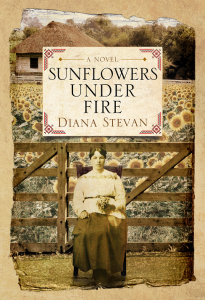
Lizzie: They say all fiction is autobiographical. What is the most significant event/setting for you personally in the story and why?
Diana: For me personally the most significant event in this story happens in the earlier part of the novel. It’s when baby Eudokia (my mother) is gravely ill and has an encounter with royalty on a refugee train. I had some information about it but again, this is fiction, so I had to research those times and that place to do justice to the tale.
Lizzie: So, when writing, do you like to plan in detail or set up a situation and see where it takes your characters?
Diana: When writing, I’m very much a pantster which means I have some idea of where I’m going in the story but I don’t always know how I’m going to get there. I like the characters guiding me for much of the way. In Sunflowers Under Fire, I had an outline, based on my mother’s anecdotes, and I organized them chronologically. But what I had were essentially bare bones. It took me a while to get into the heart and mind of Lukia Mazurets, my grandmother. Though I shared a bedroom with her for the first fifteen years of my life, she never talked about her past in the old country.
Lizzie: Where and when would you like to set another novel? Why?
Diana: I have so many ideas but I’m thinking of doing a sequel to Sunflowers Under Fire, set during the Great Depression in Canada. The 1930s was a very difficult period for many Canadians (also Americans) due to the fall of the stock market in 1929 and the drought that hit the mid-west. It was especially hard on immigrants who left their countries for a dream that fell apart not long after they’d arrived.
Lizzie: Is there an important theme (or themes) that this story illustrates?
Diana: Faith will get you through the most horrific times. War does not solve a problem; it only makes matters worse. And a mother who loves her family will do anything to make sure her children are safe and secure.
Lizzie: What is the role of superstition and tradition or innovation and dystopia in this story?
Diana: Lukia Mazurets is superstitious and relies on her dream book to give her answers. To say more, would give away some key turning points in this story.
Lizzie: What do you learn about change and social classes in this book?
Diana: Because this story is set during World War I in Russia, the reader is confronted by the differences between how the royals lived and how the peasants lived. It was the reason for the Bolshevik revolution. The poor had had enough.
Lizzie: Thank you so much, Diana, for your insights as to how you can illustrate huge themes through the prism of one family’s experiences (fictionalised, of course).
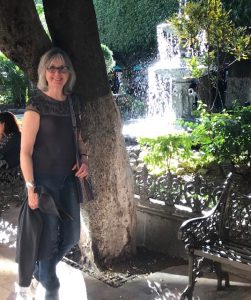
February 2019, at Guanajuato, taking a break as a participant in the San Miguel Writers’ Festival.
Author Diana Stevan has worked as a family therapist, teacher, actor, and CBC sports reporter. She’s published poetry, a short story, newspaper articles, a novelette The Blue Nightgown and two other novels, A Cry From The Deep and The Rubber Fence. She lives in West Vancouver and Campbell River with her husband.
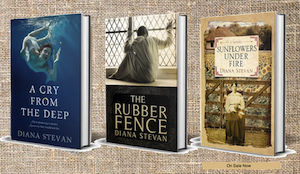
To find out more about Diana Stevan and her work, see her author website. She can also be contacted through Twitter, Instagram, Facebook, LinkedIn and Pinterest.
To buy her books, see:
Kobo:
21st March 2019
And now for something rather different. This month J L Gilliland is introducing us to the thought processes behind the writing of The Descent of Lakshmi, an historical fantasy. Welcome to An Author’s Mind, J L!
J L Gilliland: Thank you, Lizzie. I really appreciate the opportunity to do this.

Lizzie: So could you introduce us to the idea of historical fantasy by telling us something of the story of The Descent of Lakshmi.
J L Gilliland: It’s a pleasure. In a time before gods ruled India, the Mother—A Sacred Fig—stood guard over a small village in the Indus Valley. During a catastrophic storm, the Mother is struck down, undermining the Shaman’s leadership over Ganweriwala and igniting religious rivalries. Stakes escalate when Lakshmi, an outsider, is declared the Incarnated Mother and dragged into their conflict. She inadvertently awakens an embittered cosmic entity that threatens to consume the entire valley. Unless she can harness her energy, the humanity she came to experience will become the species she destroys.
Lizzie: Who is/are the hero(es)? Who are the villains? And why?
J L Gilliland: I hesitated to answer this question, then realized it plays a huge role in what I write and why. I don’t see people in absolutes but shades of gray. When I watch movies or read books, I want complexity in the characters: good reasoning and bad behaviors or maybe bad reasoning and good behaviors, etc. That said, I don’t consider any of my characters to be heroes or villains, but flawed people who are struggling to deal with difficult situations. They make good and bad choices, some that work and others that don’t. Sometimes they’re selfish and self-centered, other times they are generous. That gives me a lot of leeway to introduce unexpected situations.
Lizzie: Do you empathise with any of these people or wish you were more like them?
J L Gilliland: While writing the book, I first heard the phrase, “everyone is the hero of their own story,” and that really stuck with me. I have four POVs (Points of View) in my book: Lakshmi, the Shaman, the riverman, and the “villain.” When I got inside these very different people and saw the world as they saw it, I naturally became empathetic towards their viewpoint. That was particularly noticeable for me when I was working on the “villain.” The more I examined his underlying motives, the more I realized that his behaviors might be undesirable, but his reasoning was sound.
Lizzie: Do your characters change in your story? Is this important?
J L Gilliland: I have two advanced degrees and both have the same core focus: why do we do the things we do, and how can we be better. I wouldn’t write if I couldn’t delve into those same issues for my characters. Change is constant in our lives. Nothing stays the same. For that reason, my characters are constantly having to adapt to a changing environment, changing social structures, changing values, and even changing faith.
Lizzie: What moments in the novel do you like best?
J L Gilliland: Some of my favorite scenes are when Lakshmi is trying to adapt to her flesh. Because it is new to her she behaves like a child who is struggling to get her body to cooperate. Sensations are also new, so she tests and tastes everything. I had quite a few giggles over those sections.
Lizzie: They say all fiction is autobiographical. What is the most significant event/setting for you personally in the story and why?
J L Gilliland: The Shaman experiences a devastating blow to his faith that leaves him reeling. That scene is reminiscent of something I experienced in my own life. Of all the characters, I would say that I understand the Shaman the most because he is trying to make sense of a world that doesn’t make sense to him anymore.
Lizzie: When writing, do you like to plan in detail or set up a situation and see where it takes your characters?
J L Gilliland: In the past, I wrote by the seat of my pants and quickly realized that method doesn’t work well for me. For The Descent of Lakshmi, I plotted out the story using the following questions: “If” a cosmic entity clothes herself in flesh, “then” she would arrive naked. “Therefore,” she would consider clothes to be suffocating. “If” she considers clothing to be suffocating, “then” she would refuse clothes. “Therefore,” she feels every physical sensation, etc., etc. Once I had the logical progression of the story, I began constructing all the Scene and Sequel sections in the book. This method leaves out a lot of details, but provides me with the vital components.
Lizzie: What is the role of superstition and tradition or innovation and dystopia in this story?
J L Gilliland: I had to research shamanism and animism in order to create a world where people believe that spirits inhabit everything and can torment the living. Shamanism includes rituals like spirit-quests and blood sacrifices, as well as questionable healing practices. According to Vedic texts (written more than two thousand years after this timeframe), the Hindu gods were originally nature spirits (like animism). Because I never do anything easy, I decided that the villagers would be in the midst of a spiritual transition from pure animism to Mother worship. That transition will eventually involve Lakshmi.
Lizzie: What do you learn about change and social classes in this book?
J L Gilliland: This story occurs in the Indus Valley Civilization (also known as the Harappan Civilization and, the Meluhha Valley Civilization). Based on the layout of the cities, archaeologists believe there was a class hierarchy, so I included it in my book. The merchant and administrative classes would have lived on the Citadel, the tradesmen would live in the lower city. Issues involving social class structure play a significant role in the book.
Lizzie: How would you describe the genre of your book, if any? What drew you to this genre?
J L Gilliland: My genre is historical fantasy or mythology. It was a natural extension of my interests. I have studied ancient history for more than 20 years. I initially focused on the Mesopotamian region (Sumer in particular), but expanded out to the Indus Valley Civilization. It is part of the cradle of civilization, once surpassing 5 million people, including cities of over 50,000. They created modern city layouts, sophisticated sewage systems, learned to adapt to climate change, engaged in widespread trade, used standardized weights and measures, etc. And then there was the biggest mystery of all: why they disappeared from history for thousands of years.
Lizzie: How do you research a novel? How do you include what you learn?
J L Gilliland: In 2003, I began researching pre-historic Sumer (in Mesopotamia) for a different novel when I encountered information about the Hindu gods. I started researching their mythology online and in the library. I initially intended to place the story on another world (Viakuntha—a Hindu mythic world), but once I decided on prehistoric India/Pakistan, I started delving into archaeology, climatology, topography, linguistics, etc. I use the research to describe the village layout, buildings, floodwall, tools, clothing, trading routes, boats, other cities, food, farms, forests, climate, social hierarchy, bartering, etc.
Lizzie: What comes next?
J L Gilliland: The Rise of Lakshmi, Mythic Book 2 comes next. The final scene in the first book is not a cliff-hanger but it does introduce another situation and new characters. Since Book 1 only covers 5 days—and a lot happens in those 5 days—Lakshmi’s story is far from complete.
Lizzie: How far along are you with your new project?
J L Gilliland: As I was writing the first book, I began outlining the second. There was so much story that I decided to leave hints of ideas that I wanted to expand upon in a later book. Once I started keeping a record of these “hints” an actual outline emerged. And, of course, that began influencing the direction of the first story. Since I’ve just completed the first novel, I’m taking a breather before starting the second. I do hope to have it written by early Summer 2019.
Lizzie: Thank you so much for such perceptive insights into your writing processes. Always fascinating to hear how another author works!
JL Gilliland is an avid student of ancient history, mythology, and human motivation. She has been researching the Indus Valley Civilization and Hindu mythology since 2003, convinced there was an epic tale laying there, waiting to be written. That research culminated in the first Mythic novel, The Descent of Lakshmi.

If you want to learn more about this author, you will find information on her website and Facebook. And her books are available to buy on Amazon.
22nd February 2019
Snowdrops may bristle in the garden but the evenings are still chill enough to demand a cosy fire and some cosy crime to warm you up. And reading doesn’t come much cosier and warmer than the books of author Debbie Young, this month’s An Author’s Mind contributor.

Angela Fitch Photography
Lizzie: Welcome, Debbie!
Debbie: Thank you, Lizzie, and thank you for the opportunity to appear on An Author’s Mind.
Lizzie: An Author’s Mind provides us with insights into the fascinating writing processes of each contributor so which book would you like to talk about today?
Debbie: Springtime for Murder. This is the fifth Sophie Sayers Village Mystery, set in the Cotswold village community of Wendlebury Barrow. Bunny Carter, the elderly widow from the Manor House, is left for dead in an open grave in the village churchyard. Sophie Sayers is sure it’s a case of foul play, but when it comes to suspects, she’s spoiled for choice. One of Bunny’s squabbling children from her three different marriages? Petunia Lot, the parasitical fundraiser from the local cats’ home? Her nephew – and one of Sophie’s best friends – Billy Thompson? All had motive and opportunity. But can Sophie and her boss/boyfriend, local bookseller Hector Munro, stop her attacker before he or she strikes again? A lively array of eccentrics joins the regular cast of characters in this compelling story of family, friendship, love and loss. While the story includes plenty of wit and humour, it’s also thoughtful and poignant, reflecting Sophie’s growing wisdom, self-reliance and skill as amateur village sleuth.
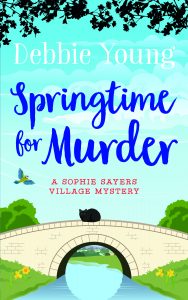
Lizzie: How would you describe the genre of your book, and what drew you to this genre?
Debbie: It’s very much a cosy mystery (or cozy mystery, as Americans term it) – a gentle crime story that is family-friendly, ie nothing gory, explicitly sexual or obscene. It’s the antidote to darker crime writing such as Nordic Noir and, I hope, a force for good. Reviewers have come up with ingenious ways to describe my particular brand of cosy mystery, e.g. rose-tinted mystery and feel-good murder! I like cosy mystery because it’s upbeat, positive and thoughtful without being preachy, and has a broadly happy ending for everyone except the murderer and the victim! It’s also a norm for the genre that the victim should be someone that people have good reason to dislike (not that disliking someone gives you licence to murder them!) and the murderer is pretty unpleasant too. I’m an optimist who loves happy-ever-afters, without losing touch with reality!
Lizzie: Who is your favourite character and why?
Debbie: I love the spirited, naughty and devious old lady Bunny Carter, who tries to manipulate her family and friends to her own advantage. Her mind is razor-sharp, and although she has limited mobility due to her old age, she has an incisive mind and a passion for good books. But her situation is bittersweet, because things don’t always go according to plan – not least the death of her three husbands! Still, she’s always ready to bounce back and try again… This book marks Bunny’s first appearance in this series, and I loved getting to know her.
Lizzie: Do your characters change in your story – and it important that they do?
Debbie: Yes – they change within each novel, because the story provides them with the opportunity to learn and grow, and to my mind that makes them more believable and important. Otherwise, it would be like writing episode after episode of situation comedy, and a more superficial read. The characters present throughout the series – particularly the central characters, Sophie Sayers and love interest Hector Munro – also develop in a larger story arc, so that from start of Book 1 to the end of book 7, they will have grown considerably – and, I hope, to the satisfaction of the reader, as well as being more satisfying and interesting for me to write. Having an overall development plan as well as growth within each book has been part of my plan from the inception of the series.
Lizzie: What moments in the novel to you like best?
Debbie: Early on there is a scene in the graveyard where two local children discover the supposedly dead body of the Easter Bunny. I had great fun with one-liners and misunderstandings, but I also really enjoyed researching and writing about the gravedigger’s perspective. Their old friend Billy is the gravedigger and his knowledge and experience really enrich the scene. I was lucky enough to catch by chance a BBC Radio 4 programme called “How to be a Gravedigger” which really helped with the detail, and really boosted my admiration for the profession! I also really like the hospital scene in which Sophie and Hector go to visit Bunny and find she is up to her old tricks. I love writing very old and very young characters, and Bunny is terrific fun. Sophie and Hector’s first visit to Kitty, the addled, aging hippy daughter of Bunny, was also good fun – let’s just say her hospitality skills leave a lot to be desired! There are also a few twists and turns at the ends of chapters that I’m really proud of, which I hope will wrongfoot the reader in classic style!
Lizzie: Which moments do you like least?
Debbie: Inevitably the murder. Having settled upon featuring the word “Murder” in the titles for the whole series a couple of years ago, I quickly realised that I don’t like killing people, which I’m sure my friends and family will be glad about! I even do a talk called “The Reluctant Murderer” at literature festivals about the role of murders in mystery stories and why I’d rather have a mystery with no murder!
Lizzie: They say all fiction is autobiographical. What is the most significant event/setting for you personally in the story and why?
Debbie: The inspiration for the story was a family of children I was at school with, who shared a famous classical musician ancestor, and the same father. Between them they had three different mothers, yet they all looked very similar physically, both boys and girls, almost like clones. I didn’t know them well, but I was transfixed by them visually, and used to sit in class surreptitiously gazing at one of their number, imagining the backstory of their home-life. (I’ve also always been fascinated by identical twins – I wished I was one when I was little!) The story was also partly driven by how much I value my own family. I come from a large but close and happy family, but every family has its differences now and again, and it was a great source of sadness to us all when my mother’s brothers fell out immediately after their mother’s death, remaining at loggerheads till their father was diagnosed with terminal cancer. I have a very vivid memory of seeing them standing in the front garden, their arms around each other’s shoulders, finally reunited as they waited for the arrival of the hearse for my grandfather’s funeral, after five years of fighting when they could have been comforting each other on the loss of their mother. Bereavement does terrible things to families, and I hope that by writing about that issue, I might help other families avoid such distress.
Lizzie: What did you learn about yourself writing this novel?
Debbie: I learned that while I love making people laugh (“a laugh on every page” says one review), I am maturing as a writer and want also to address more serious themes, using my trademark comedy as comic relief. I think in each of my books there are moments when I might bring a tear to the reader’s eye, whether at a poignant romantic moment or at a heartrending confession of vulnerability by one of the characters, but I feel that I’ve reached the best and most mature balance yet in this book, which makes me very happy.
Lizzie: Where and when would you like to set another novel and why?
Debbie: The next Sophie Sayers Village Mystery will be set mainly on the idyllic Greek island of Ithaca, where Sophie goes to take part in a residential writers’ retreat, although it will be topped and tailed in her home village of Wendlebury Barrow. I particularly wanted to put Sophie to the test beyond the village where she has been quietly transforming during books 1-5 from anxious under-confident apologist to assertive and sparky independent thinker, to stretch and develop her further. There are two reasons I chose this particular setting. Firstly, because I was lucky enough to be a guest at a writers’ retreat on Ithaca a few years ago (an island I’d already visited numerous times in my sailing days and loved very much), and it was a fabulous experience – isolating, weird, and exposing, but it was at that retreat that I finally realised that I really could write a novel – and I haven’t stopped since! Secondly, I have a very, very wide circle of writer friends, and you simply couldn’t make up some of those personalities! But I shall have great fun inventing the characters in my fictional writing retreat and setting them all in conflict with each other. And pushing one of them off a cliff to their death, incriminating Sophie as number 1 suspect…
Lizzie: Could you lose yourself in this novel’s world? Why?
Debbie: Actually, I already live in a village very much like Sophie’s Wendlebury Barrow, and I never want to live anywhere else. So it bemuses me when readers sometimes take it to be a nostalgic, idealised village, harking back to a bygone age, just because the village doesn’t have Uber cabs or Deliveroo services. Sometimes reviewers say they wish they could find such a place in the modern world. I long to tell them that actually, if you just seek them out, such rural communities, where everyone is allowed to be themselves and looks out for each other, such places really do still exist. I know, I’ve lived in one for nearly thirty years! When people tell me they are glad to escape to Wendlebury in Sophie’s latest adventure, I take that as a great compliment – and hope that one day they too will find their real-life equivalent where they can live happily ever after.
Lizzie: What comes next?
Debbie: I’m currently in the finishing straits of Flat Chance, the first novel in a new series, The Staffroom at St Bride’s Mysteries, set in a traditional girls’ boarding school, where all the staff have secrets to hide – and new arrival Gemma Lamb, herself running away from a disaster in her personal life, sets out to untangle various puzzles. This is also inspired by personal experience – I worked at a famous girls’ boarding school for 13 years, so have spent many hours in the staffroom caught up in similar intrigues! Although satirical in some respects, it is a gentle, affectionate story, with the usual fiction writer’s rider that any similarity to people, places or events is entirely unintentional!
Lizzie: Thank you, Debbie, for lots of frank and in-depth answers.
Debbie: A great pleasure!
Debbie Young writes warm, witty, character-driven cosy mystery novels, filled with English humour and observational comedy. When complete, the Sophie Sayers Village Mysteries will consist of seven novels spanning the course of a village year from one summer to the next. She has also published three themed collections of short stories and had numerous stories feature in anthologies. She is founder and director of the free Hawkesbury Upton Literature Festival, now in its fifth year, and a panellist on BBC Radio Gloucestershire’s monthly Book Club slot. She runs writers’ groups in Cheltenham and Bristol and is an advisor and UK ambassador to the Alliance of Independent Authors. She is ambassador to the children’s reading charity Read for Good and also to the Type 1 diabetes charity JDRF. She has lived in a small Cotswold village for nearly half her life, serving on nearly every village committee, and celebrates community life in her writing.

Debbie and The Bookseller’s Caroline Sanderson at BBC Radio Gloucestershire. Photo Credit: Dominic Cotter

Hawkesbury Upton Festival 2018 – the organisers! Photo credit: Angela Fitch Photography

2016 Hawkesbury Upton Festival, thanking Dan Holloway and Shirley Wright for being part of the poetry readings. A Joanna Penn photo.
If you’d like to know more about Debbie Young, her work or the Hawkesbury Upton Festival follow the social media links below:
Hawkesbury Upton Literature Festival Website
If you would like to buy Debbie’s Novels:
or her website (as above)
or any good bookshop.

Angela Fitch Photography
24th January 2019
A belated Happy New Year, everyone! New Year, lots more reading opportunities! I hope you haven’t used up all your Christmas Book tokens and vouchers! An Author’s Mind has yet another cracking story for you! This month we are exploring the writing processes of author Zara Altair. Zara Altair writes traditional mysteries set in ancient Ostrogoth Italy. A mystery fan and history buff since childhood, she fell in love with Italy on one brief visit. Welcome, Zara!

Zara: Elizabeth, it’s a pleasure to be here on your site and talk to your readers. Thank you for the invitation. An Author’s Mind is a place of imagination.
Lizzie: Thank you for that! Now to business! In your own reading, what first draws you into a book?
Zara: What a great question. For me, it’s the blurb and the first few pages of the book. I want to know if the book is something I will enjoy reading. So, the blurb tells me if the story is within my reading spectrum. Then I look at the author’s writing style because I will be with the story for a while. Do I jump right into the story? Does the main character have a personality that is readily apparent? The main way a cover influences me is that the author cares enough about the book to have a professional looking cover. That indicates the overall professional approach to the book.
Lizzie: And now, could you tell us about the novel you want to talk about today – briefly, with no spoilers?
Zara: Certainly. Several threads run through the story of The Roman Heir – a naïve teenager; a sister with secrets; a corrupt patrician. And it’s down to Argolicus to unravel them. When Argolicus leaves Rome to retire to his estate in southern Italy, his powerful friend Boethius asks a small favor, deliver a book to a young man in Ostia. When he arrives in the dying resort town, he finds chaos and sorrow in the villa. The young book lover’s father was viciously murdered just hours before and the young man asks Argolicus for help.
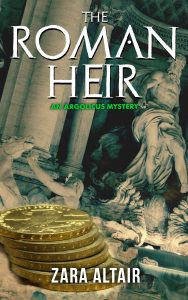
Lizzie: How do you build your world?
Zara: Because the genre is historical fiction, I have a generous amount of background research about the civil, political, and social structure of early 6th Century Italy. But each story has its own world. The Roman Heir is set is Ostia at a time when it has lost most of its prestige. The big port of Portus is across the river and the town remains as a “seaside” resort for wealthy Romans. I had to do research about the town at this time, the social customs in Rome, and because the murder victim trades in goods, background on warehousing, distribution, and safekeeping. People are people no matter when they exist, so creating the characters is much easier for me than collecting all the details of the world around the characters.
Lizzie: When writing, do you like to plan in detail or set up a situation and see where it takes your characters?
Zara: A bit of both. I have an overall plan for the story and each chapter. The plan assures me that I am planting clues early on and developing the suspects in the mystery and a way the leads readers on. I have notes for each chapter so it fits into the overall story structure. But, once I start writing characters do and say things that I had not planned. Those surprises make the story more interesting for me and for the reader.
Lizzie: They say all fiction is autobiographical. What is the most significant event/setting for you personally in the story and why?
Zara: For every writer, his or her work holds bits and pieces of life and the people we meet: Characters, based on people encountered decades ago, or a sense of smell from a trip. I spent years teaching writing and, in this novel, the young man, Philo, is based on an exceptional high school student. The protagonist, Argolicus, has the reasoned determination of my son. Members of my writing group who know him have said more than once, “I can hear him saying that.” The setting in Ostia with the muddy marsh plants is based on years of rambling by the ocean. And as a sailor, the ships in the harbor and the boat journey to the harbor are direct experiences of being on board.
Lizzie: Could you lose yourself in this novel’s world? Why?
Zara: Oh, I hope so. I want readers to have a sense of the characters moving through the homes and streets, the harbor and the forum so the world feels natural to the characters.
Lizzie: How do you research a novel? How do you include what you learn?
Zara: For the series, The Argolicus Mysteries, I have done a lot of reading, travel to Italy specifically to interview history professors for more background and serendipitous finds. Each story has a specific focus. In The Roman Heir I researched shipping, and the details of Ostia and Portus at the time. I include the details as the characters move through the story. Every story includes about 20 per cent of the research details I accumulate. The broad background is important because I don’t know what specific details I will use until I am writing.
Lizzie: Is there an important theme (or themes) that this story illustrates?
Zara: Mystery always includes the theme of how little we understand other people. Argolicus peels back layers of revelation about a murder victim. The revelations lead him to the murderer. In this story, the theme is the secrets people try hide, reveal themselves in unexpected ways.
Lizzie: What does this novel tell you about the difference between fiction and non-fiction?
Zara: The allure of mysteries comes from a puzzle solution. Whether a reader discovers the perpetrator before the mystery’s sleuth, solving the puzzle is the attraction. In life we face disappointments, frustrations, fears, and disasters but a mystery can put together all the pieces because it is a work of fiction. In real life, not all puzzles are solved. We have to live with not knowing. I have known three people who were murdered at different times and none of these murders have been solved.
Lizzie: What comes next?
Zara: I am excited about the next Argolicus Mystery, The Grain Merchant. It’s a full-length novel which gives me room to play with more themes – social unrest, political intrigue, and slavery. Argolicus moves from his villa in the country to open the old family home in town. He is immediately drawn into local politics and a murder that could have many reasons.
Lizzie: How far along are you with your new project?
Zara: I am raising funds for editing and book cover creation on Kickstarter. The project is selected by Kickstarter as a Project We Love. I’d love for your readers to check it out. This is my first crowdfunding experience, and it is involved and intense. Readers can visit it by the link below.
Thank you, Elizabeth!
Lizzie: Thank you for your insightful responses! And we’re pleased to know The Argolicus Mysteries is an ongoing series.
If you’d like to know more about Zara Altair, find her on her website.
You can also follow her on:
If you want to dip into The Argolicus Mysteries, try Google Play Books for both print and audio versions.
And, if you’d like to investigate – and perhaps invest in – Zara Altair‘s crowdfunding project for The Grain Merchant, see Kickstarter .
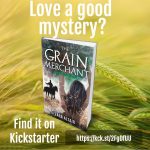
20th December 2018
Hildegard of Bingen (a real person) is a supreme example of Renaissance Woman. I have often toyed with the idea of reading – and writing – about her but now P K Adams has written The Greenest Branch, everything I could wish for is in print! So when Christmas Day comes, along with a harvest of book tokens, The Greenest Branch will vie for my attention with many other books written by the wonderful authors in the An Author’s Mind series. And I commend them all to you!
So, welcome to my blog, P K Adams, and may I say what a delight it is to have you here.
Thank you, Lizzie, it’s a pleasure for me to be here.

Lizzie: It’s a busy time of year so let’s crack on. Could you tell us the story in brief (with no spoilers) of The Greenest Branch?
Pat: In the year 1115, young Hildegard arrives at the Abbey of St. Disibod in the German Rhineland hoping to become a physician. But she soon finds out that as a girl she will not be allowed to attend the monastic school; instead, she must stay at the women’s convent, isolated from the rest of the community and from the town. But Hildegard refuses to be sidelined. Against fierce opposition from Prior Helenger, she secures an apprenticeship with Brother Wigbert who runs the infirmary and is in dire need of a capable assistant. Under his supervision, she begins to train as the abbey’s first female doctor. When Hildegard’s reputation starts to spread throughout the Rhineland, Helenger’s persecution escalates as he fears losing control over the women’s community. But that is not the only challenge she must grapple with. She has also developed feelings for Volmar, a fellow Benedictine novice, that force Hildegard to re-examine the fundamental assumptions she has made about her life. Is the practice of medicine within the monastic confines her true calling, or is a quiet existence of domestic contentment more desirable? With the pressures mounting and threatening to derail her carefully-laid plans, Hildegard becomes locked in a struggle that will either earn her an unprecedented freedom or relegate her to irrevocable oblivion.

Lizzie: Which three words describe how you felt, having finished writing The Greenest Branch. . . .?
Pat: ‘Accomplished’, ‘exhausted’, ‘antsy to get started on a new project’.
Lizzie: Do your characters change in your story? Is this important?
Pat: The story spans most of Hildegard of Bingen’s life—from the age of 11 to 75. So it that sense she definitely changes! Over the years, her views mature and evolve: she develops a philosophy of nature that underpins her medical practice and her treatment of other people and the world around her. But as she becomes more understanding of human weaknesses and more cynical about the power structure of her times, her determination to fight against those who want to hold her back gets stronger. One thing that is consistent in Hildegard’s life is her belief that she can chart her own path through life rather than trying to fulfill the expectations that others have for her.
Lizzie: What moments in the novel do you like best?
Pat: I like it when Hildegard rebels against the societal strictures that stand in the way of achieving her dreams. She rebels and succeeds in pushing the detractors and naysayers aside as she moves closer toward her goal. The reason these are my favorite moments is because I have a similarly contrarian nature, though I am not nearly as effective as Hildegard!
Lizzie: What moments do you like least?
Pat: When men (of the Church—here exemplified by Prior Helenger) justify keeping women away from public life and education by claiming that they are unable to think abstractly, and that they don’t have sufficiently developed reasoning faculties. These were very common beliefs in the Middle Ages.
Lizzie: When writing, do you like to plan in detail or set up a situation and see where it takes your characters?
Pat: I am a planner – in life and in fiction! Fortunately, I am flexible enough to be able to let go of something I had outlined at the beginning that may no longer work when I get to that point in the story. But I would never sit in front of a blank page and start writing. It would be too intimidating. With a plan/outline in hand as a guide, I feel much more confident when I set out on the writing journey.
Lizzie: Is there an important theme (or themes) that this story illustrates?
Pat: One of the major themes in The Greenest Branch is a woman’s dilemma between focusing on family and having a life that is fulfilling outside the home, in the public arena. For most women in the Middle Ages (i.e. those who were not royals) those paths were mutually exclusive. Typically, if a woman wanted to gain an education and lead a (relatively) independent life, she had to become a nun. In the story, the young Hildegard grapples with that dilemma and has to make difficult choices. While fortunately women have more freedom and more options today, I think there is still an aspect of our lives where we must make harder choices between the public/professional and the private than men do, and for that reason the story is universal. I believe that many women will be able to recognize something of what they have experienced or are experiencing in their lives today.
Lizzie: What is the role of superstition and tradition in this story?
Pat: Both superstition and tradition play a huge role in The Greenest Branch. Superstition regarding herbs and their healing properties is at the root of the Church’s distrust with non-surgical medicine and with women who practice herbal healing. It is an obstacle that Hildegard consistently battles against. As far as tradition is concerned, women in the Middle Ages were perceived as intellectually inferior to men and unable to exercise reason to the same degree. That was why their access to education was so limited. Hildegard—with her intellect and her desire to learn—went against all those beliefs and experienced a lot of pushback as a consequence.
Lizzie: What do you learn about change and social classes in this book?
Pat: We learn that the medieval society was not only divided along the economic and class lines—i.e. poor commoners/laborers vs. wealthy nobility. It was also very strictly separated along gender lines. Women’s role in the family and outside the home was very clearly and narrowly defined, and few women dared to challenge the status quo. That is what makes Hildegard such an unusual woman for her times.
Lizzie: How do you build your world? How do you describe it? Sensory perceptions? A stream of consciousness? Reflection? Anything else?
Pat: The medieval world was fascinating and very different from ours. I had researched it meticulously not just through reading history books, but also watching movies and TV series set in the Middle Ages. I created the world in The Greenest Branch by describing the setting—the buildings, tools of everyday life, landscape, nature—in sufficient detail to establish a sense of place. Whenever I could, I added sensory details such as scents of flowering plants, different types of food, or even the not-so-pleasant smells associated with medical work in the infirmary. In historical fiction, it is important to be authentic, and that means sometimes describing smells, sounds, and views that may be unsavory.
Lizzie: How do you research a novel? How do you include what you learn?
Pat: I read both non-fiction (history books) and fiction set in the period I write about. I take copious notes, and I include a lot of details in the first draft. In subsequent rewrites I remove anything that’s not directly related to the story, no matter how much I may like a certain factoid. That’s one of the hardest things about writing historical fiction.
Lizzie: What would you tweet (in 147 characters) about this book?
Pat: True story of a young woman enclosed in a convent who defies the hierarchy of the medieval Church in her quest to become a physician.
Lizzie: What did you learn about you, writing this book?
Pat: That I can be doggedly persistent if I do something I care about.
Lizzie: Where and when would you like to set another novel? Why?
Pat: My next project is a historical mystery series set in 16th century Poland, at the royal court in Cracow. After the medieval era, the 16th century is my favorite historical period, but I feel that too much fiction set in that era is focused on England and France. I want to show that other parts of Europe also had their Renaissance, and that life there was every bit as exciting, dangerous, complicated, and glamorous as at the Tudor court.
Lizzie: How far along are you with your new project?
Pat: I just finished the first draft!
Lizzie: Thank you so much for sharing all this fascinating detail with us!
P K Adams is a Boston-based historical fiction author with a degree in European Studies from Yale University and former marketing copywriter and editor. As she says, ‘A life-long lover of history, my goal is to bring stories of lesser-known historical figures and places to the attention of wider audiences. I have a blog where I share my writing journey, review historical fiction, host guest blogs from fellow authors in the genre. When not writing, I can be found drinking tea, practicing yoga, watching British murder mysteries on Netflix … although usually not at the same time.’
If you want to know more about P K Adams keep in touch through her website, Facebook and Twitter.
If you want to spend your Christmas largesse on The Greenest Branch, try all good bookshops or Amazon US and Amazon UK.
P K Adams notes: The Greenest Branch is the first book in a two-part series. The second book, The Column of Burning Spices, will be released in January 2019.

26th November 2018
In her latest novel, librarian turned novelist Ali Bacon marries two passions: fiction and photography. And this month, on An Author’s Mind, we are lucky to find out why and how.

A warm welcome, Ali, particularly from those of us drawn to the visual. Perhaps you could begin by introducing the novel you want to discuss, In the Blink of an Eye.
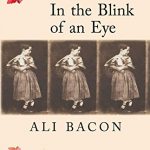
Ali: Thank you, Lizzie. After graduating from St Andrews University, I worked in Oxford’s Bodleian Library where I found a cache of famous Victorian photographs. This sparked a life-long interest in early photographers. And In the Blink of an Eye is a re-imagining of David Octavius Hill’s life in the words of those who were beguiled by his artistry and charismatic charm. Tender, tragic and sometimes humorous, these voices come together in a story of art and science, love and loss, friendship and photography.
The story briefly goes: He had Edinburgh at his feet, but who would be by his side? In 1843, recently widowed Edinburgh artist David Octavius Hill is commissioned to paint the portraits of 400 ministers of the Free Church. Only when he meets Robert Adamson, an early master of the new and fickle art of photography, does this daunting task begin to look feasible.
Lizzie: Which three words describe how you felt, having finished writing In the Blink of an Eye?
Ali: Usually I feel a little sad when I finish a novel because I am saying goodbye to the people I have lived with for so long. This time there was a less sadness and more satisfaction and elation at bringing the project to a close. And I have not lost these people – they were real people and I still give talks about them. They are with me still!
Lizzie: How would you describe the genre of your book, if any? What drew you to this genre?
Ali: It’s at the literary end of historical fiction and I was drawn to it through the power of one (real) man’s story; artist and photographer David Octavius Hill. The story is told in separate episodes through the voices of people who knew the ‘hero’. I really enjoyed writing it like this and have occasionally described it as linked short stories, although it has an overall story arc.
Lizzie: Who is your favourite character and why?
Ali: The most fun to write was Elizabeth Rigby, a writer and critic who became Lady Eastlake and may at one time been my hero’s ‘sweetheart’. She became well-known and left copious diaries and letters which betray a very lively and forthright character. Sometimes historical facts get in the way of fiction, but she seemed to give me more to work with all the time.
Lizzie: If you were a casting director for a film/tv version, who would you cast in which roles?
Ali: Lady Eastlake actually appears in the film Effie Gray (2014), played by Emma Thompson. Excellent casting – I would have her again!
Lizzie: What moments in the novel do you like best?
Ali: As a writer my absolute favourite moment is the opening two sentences. I had invented a new character to provide the last chapter and finish off the story. As soon as I began writing him, I realised he was the key to the structure of the book and needed to be at the start. Eureka! – the book was complete. After a struggle of several years that was a great moment.
Here it is:
“Before he left for Edinburgh, Malcolm Scobie, minister of the Free Kirk in Blairgowrie, spoke to his housekeeper and to his beadle, explaining he’d be gone for two days but back in plenty of time to compose his Sunday sermon. He also took it into his head to write to Louisa…”
Lizzie: They say all fiction is autobiographical. What is the most significant event/setting for you personally in the story and why?
Ali: As a historical novel this was never going to be autobiographical but the opening chapters are set in St Andrews which I knew well from my student days and the artists Noel and Amelia Paton, who play a significant part, are from the town where I was brought up [Dumfermline]. I enjoyed delving into what felt like my own history and hope this resonates in the writing.
Lizzie: Is there an important theme (or themes) that this story illustrates?
Ali: One reviewer has said that the novel is about bereavement and grief and as in all Victorian life this is an unavoidable part of the story. Towards the end, as the hero struggles to complete a commission for the Church, there are strong overtones of the importance of duty in both worldly and religious sense, but what I wanted to convey overall was a feeling of redemption and of hope for the future.
Lizzie: What do you learn about change and social classes in this book?
Ali: I have learned that the Victorians are more like us than I realised! Women, although not unfettered, could still take up all kinds of opportunities. International travel – you could almost call it tourism – was commonplace among the better off. Despite the gap in wealth, the fisherfolk of Newhaven (Edinburgh) could be on speaking terms with artists and social reformers.
Lizzie: What does this novel tell you about the difference between fiction and non-fiction?
Ali: One eminent photo-historian has said In the Blink of an Eye brings ‘colour and texture to a story previously known in black and white’. That’s very gratifying as I suppose it’s what I was trying to do. But D. O. Hill appears mainly in books about photography and my book is not about photography. It’s about a group of people who happened to come together in that milieu and how it might have been for them to be there. I hope it will bring the story to a new audience of novel readers rather than art- or photo-historians.
Lizzie: Does the book remind you of any other writers or novels you’ve read? What’s the same? What’s different?
Ali: Despite being a great fan of historical fiction I can’t think of anything similar to Blink in that field. However there are points of similarity with contemporary novels which use a form of linked short stories. I’m thinking of Donal Ryan’s The Spinning Heart (2012) or Ali Smith’s Hotel World (2001). Very different in content but similar in form. One of my favourite historical fiction reads is The Physic Garden (2014) by Catherine Czerkawska which drew me into its world from the first sentence. If I can do that I’ll be happy.
Lizzie: What comes next?
Ali: Historical fiction was a new departure for me and one I did regret from time to time along the way, but although I write contemporary short stories, I can’t help feeling my next big project will take me back to a similar period – watch this space!
Lizzie: Thank you, Ali, for all these fascinating insights.
If any readers want to know more about Ali Bacon, please see her social media links:
Twitter @AliBacon or her Facebook Author page
And you can buy In the Blink of an Eye at all good bookstores, Amazon Uk and Linen Press.

25th October 2018
We are delighted to welcome the highly-experienced author, Rosemary Kind, on this month’s An Author’s Mind blog and Rosemary has chosen to discuss with us her most recent novel, New York Orphan.

Welcome, Rosemary! It’s a delight to have you here on An Author’s Mind!
Rosemary: Thank you, Lizzie. It’s lovely to have the opportunity to describe my writing processes, especially in relation to New York Orphan.
Lizzie: Could you tell us a little about the story, Rosemary, obviously keeping your secrets!
Rosemary: From fleeing the Irish Potato Famine, to losing his parents on the ship to New York, seven-year-old Daniel Flynn knows about adversity. As Daniel sings the songs of home to earn pennies for food, pick-pocket Thomas Reilly becomes his ally and friend, until he too is cast out onto the street. A destitute refugee in a foreign land, Daniel, together with Thomas and his sister Molly, are swept up by the Orphan Train Movement to find better lives with families across America. For Daniel will the dream prove elusive? And how strong are bonds of loyalty when everything is at stake?
Lizzie: Who is your favourite character and why?
Rosemary: I’ve grown close to all the main characters. I think while I was writing it probably Miss Ellie, but now I’m on the second in the series and Molly is an adult I’m right there with her.
Lizzie: Do you empathise with any of these people or wish you were more like them?
Rosemary: I have never been in their shoes, but I couldn’t help but feel their struggle with them. Right from their fighting starvation to the lives they have gone on to lead. Reading about the potato famine and about lives on the streets of New York and the real hardships they faced moved me to tears many times and I hope that has been conveyed to the reader.
Lizzie: I’m sure it has. As Robert Frost said, ‘No tears in the writer, no tears in the reader.’ Which character would you most like to invite to dinner this evening and why? Who would you invite along too? What would you hope to learn?
Rosemary: I’ve been going for walks with these characters almost daily for a very long time, so we know each other pretty well already. I’d like them to meet up with some modern day politicians so they could see the parallels with the current migrant crisis and realise the importance of giving people a chance in life.
Lizzie: Do your characters change in your story? Is this important?
Rosemary: Most definitely. The inner struggles, as well as the external difficulties, are vital to the development of the characters and the crux of the story.
Lizzie: When writing, do you like to plan in detail or set up a situation and see where it takes your characters?
Rosemary: I’m a planner. I know where the story is going and that’s the path it takes. Until, that is, the characters take on a life of their own and revolt! The ending of the novel is not the original one I planned. The characters simply weren’t happy with it. They had their own story to tell and gave me no choice. I’ve already written the ending of the next in the series, now I just need to wait to see if they are happy with it or not.
Lizzie: Could you lose yourself in this novel’s world? Why?
Rosemary: Totally. I’m a bit of a method writer. While I’m writing I’m living and breathing their lives. I listen to music that fits. I read related items of non-fiction. I spend my whole life talking to the characters and walking with them. I can forget what’s real and immerse myself in what is happening in the story.
Lizzie: Where and when would you like to set another novel? Why?
Rosemary: I’m currently in the late 1860s but the series will run through a number of historical events. It is giving me the chance to be part of key moments in history that happened before I was born, which really is quite a privilege. I don’t know if the characters will let me follow the next generations, but ideally I’d like to go at least as far as the years up to when I was born.
Lizzie: What is the predominant moral issue? Who understands what is ‘right’ here or does no-one?
Rosemary: I like to explore the whole question of what makes us who we are. What drives us to make the decisions we do. Right and wrong are not black and white concepts. If you are starving the way you view theft of a loaf of bread is different from those who are rich and steal more wealth. Where does one draw the line? I don’t ask the reader to agree that wrong is right, but I do try to challenge them to understand that a guilty party should not always simply be condemned for their actions. Morality is such a fascinating area. I want readers to put themselves in the shoes of the children in this book, in the way that in The Appearance of Truth I challenge them to think about the reality of being childless and what that can feel like. Life is complex. I wrote a short story years ago that sums much of it up called Wall of Shoes. An old lady has over the years collected shoes of every type – workman’s boots, school shoes, etc – it is her way of thinking about the people who might have worn them and what it would mean to walk a mile in their shoes. That’s the challenge I want to put to readers.
Lizzie: How would you describe the genre of your book, if any? What drew you to this genre?
Rosemary: This one is definitely historical fiction. I heard the story of the Charles Loring Brace of the Children’s Aid Society sending orphans across America by train to be adopted and I was off. From the point I heard about it there was a story that had to be told.
Lizzie: On re-reading, have you noticed anything that is inaccurate or inconsistent? How would you explain this away if challenged?
Rosemary: Not in that book, but I am going back to one of my early novels and re-editing it for that reason. I try very hard to research thoroughly and hate to let myself down.
Lizzie: What does this novel tell you about the difference between fiction and non-fiction?
Rosemary: Non-fiction tells you what it was like. Fiction tells you what it feels like. I don’t want the reader to look at a picture of a street in New York, I want to put them in that street and let them take in their surroundings. I don’t want them to picture a field of corn, I want them to feel the blades cut their skin as they work their way through it. Fiction brings the story to life.
Lizzie: How do you research a novel? How do you include what you learn?
Rosemary: I do a huge amount of research, both internet based and where possible in person. I don’t feed in paragraphs of detail, but use subtle detail to ensure the scene is authentic. I don’t write non-fiction masquerading as fiction, but I do make sure the detail the reader gets is correct. The language needs to be authentic and the settings believable.
Lizzie: What would you tweet (in 147 characters) about this book?
Rosemary: Daniel’s parents died onboard ship. He knows about adversity. Can the Orphan Train save his life? How strong is loyalty when everything’s at stake?
Lizzie: What comes next?
Rosemary: This is the first in a series. The next one finds the characters involved in the struggle for equality in America and in particular the campaign for votes for women.
Lizzie: How far along are you with your new project?
Rosemary: I’m about 15% through writing the first draft.
Lizzie: We look forward to the rest! Thank you so much for your fascinating insights into how you work. Is there anything more you want to tell us?
Rosemary: I write because I have to. You could take almost anything away from me except my pen and paper. Failing to stop after the book that everyone has in them, I have gone on to publish books in both non-fiction and fiction, the latter including novels, humour, short stories and poetry. I also regularly produce magazine articles in a number of areas and write regularly for the dog press.
I spend my life discussing my plots with the characters in my head and with my faithful dogs, who always put the opposing arguments when there are choices to be made.
For more details about Rosemary Kind, please visit her website. For more details about her dog then you’re better visiting www.alfiedog.me.uk
Social Media Links include:
And to buy New York Orphan, go here .
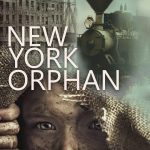
22nd September 2018
This month’s guest blog is exploring the mind of a woman of mystery! The phenomenon that is Jessie Cahalin rarely appears in photographs. We got quite close but not so close you’ll recognise Jessie in the local supermarket. However, the author of the extremely successful blog, Books in my Handbag, has also published her debut novel this year and we are delighted to peep into the mind of You Can’t Go It Alone‘s author!

Jessie with Sunglasses at Narberth
So down to business! Welcome, Jessie! This has been an exciting year for you with the publication of You Can’t Go It Alone. Can you tell us a little of the story – with no spoilers?
Jessie: It’s a pleasure to be here, Lizzie. I’m really looking forward to this.
You Can’t Go It Alone is a weaving-together of love, music and secrets. Set in a Welsh village, Delfryn, the story explores the contrast in attitudes and opportunities between different generations of women. As the characters confront their secrets and fears, they discover truths about themselves and their relationships.
Lizzie: Who is your favourite character and why?
Jessie: My favourite character is Jim Evans. His wife, Pearl, died, years ago and he has been very lonely. Originally, I intended Jim to be a minor character, but his presence evolved gradually. Jim came to life in the various scenes, and his love for Pearl is moving. His sadness made my heart ache for him. I discovered his past and the way he concealed emotions. Born into a working-class family during the forties, he was expected to be tough. Jim wrestled with expressing his emotions. His wife understood Jim’s issues, but they never managed to discuss everything. Jim and Pearl want me to explore elements of their childhood and how they met.
Lizzie: Who is/are the hero(es)? Who are the villains? And why?
Jessie: All my characters have good points and flaws. Readers have described my characters as ‘real’. Sophie is the linchpin developing the sense of community but neglects her own life. Matteo seems like an obvious villain, but he is more complex than he appears. Gio’s behaviour is all bravado. Pearl seems to have been held back yet she also failed to communicate effectively with her husband. I could go on and on but want readers to discover the characters for themselves. I will confess the obvious villain was removed from the book, as he had a negative influence on Olivia. I had to banish the character for Olivia to be independent and shine.
Lizzie: Which character would you most like to invite to dinner this evening and why? Who would you invite too? What would you hope to learn?
Jessie: I would invite Rosa to dinner and give her a break from cooking in the Olive Tree café. She is a lively, entertaining characters with lots of stories to tell, but I know she needs to talk. Hopefully, she would tell me more about Pearl. I know Pearl and Rosa met weekly but am not sure what they talked about. Although, Rosa is an exquisite cook, I am sure she wouldn’t judge my cooking. I’d ask her to bring her violin and favourite songs. I’d also like to chat to Rosa about her plans for the next community event in the café. I would also invite Angela Petch, author of Tuscan Roots, to speak Italian. I know Angela would manage encourage Rosa to be herself.
Lizzie: Do your characters change?
Jessie: All the characters change and discover something about themselves and each other. They all learn to be more open about how they feel and to work together. Changes in Olivia and Jim are at the heart of the novel. Jim learns to reach out to other members of the community. I wonder if Pearl ever knew the extent of Jim’s love for her. Olivia is young and grows in confidence as she finds her identity. However, I am not sure how Olivia will develop in the future – sometimes I see her rebellious streak.
Lizzie: What moments in the novel do you like best?
Jessie: I enjoy reading the scenes between Luke and Rosa. The tenderness between the couple feels real, and I wish they had had more time together. Luke and Rosa have very different backgrounds and opportunities but the connection between them is very strong.
Lizzie: What moments do you like least?
Jessie: At times, I have worried about Sophie. She is so absorbed in her wish to have a child that she has neglected to talk to her husband. Her anger and pain have consumed her; thus, she displaces herself with other people’s worries rather than giving more time to Jack. A cloud hovers over Sophie’s life. I do hope she learns to appreciate the simple things in her life rather than trying to help everyone else. The scenes where Jack and Sophie visit the hospital are difficult and uncomfortable.
Lizzie: Could you lose yourself in the novel’s world?
Jessie: I have lost myself in the novel’s world. Delfryn is very real to me. I have walked through the village and seen the characters. Sitting in the café, I observed Rosa and listened to the music. The food was so delicious that I kept a menu as a souvenir of the experience. Delfryn Vineyard made me feel as if I had found a secret retreat from the world – it is no wonder the monks chose this spot for their vineyard. The owners of the vineyard asked me to write a description of their wine. I struggled and ended up thinking of Marcus’s wine tasting. Thus far I have written, ‘a cheeky wine with a hint of sarcasm.’ I will visit the vineyard again to write an appropriate description for the Delfryn wine!
Lizzie: Is there an important theme (or themes) that this story illustrates?
Jessie: The book illustrates the importance of sharing worries and working together. Characters learn to enjoy the simple things in life. Communities can exist in the twenty-first century if we open our hearts and make the effort.
Lizzie: What do you learn about change and social classes in this book?
Jessie: The novel demonstrates different generations of women have different opportunities. Pearl and Olivia are two generations apart and had a different approach to pursuing their music ambition. Rosa is an independent business woman who asserts herself but places her daughter at the centre of her world. Rosa knew she had to adapt her expectations to provide security for her daughter. Sophie worked hard to have the freedom to make choices but expected to become a mother whenever she made the choice – life isn’t that simple. All these women are from working class backgrounds with other cultures integrated into their experiences.
Lizzie: How would you describe the genre of your book, if any?
Jessie: You Can’t Go It Alone is contemporary fiction. It is a book about love and romance without a predictable ending. A male reader has indicated the book ‘appeals to men and women alike’. Another reader has labeled the book a family saga, as she wanted to find out more about the families in the novel. Set in Wales, You Can’t Go It Alone is ‘a novel with a warm heart’ and is the first book in a family saga.
Lizzie: Thank you, Jessie, for an intriguing interview!
Jessie’s story
Jessie is a Yorkshire author living in Cardiff. Wales, words and Yorkshire folk have a special place in her heart. She loves to entertain and challenge readers with her contemporary fiction and wants everyone to meet the characters who’ve been hassling her for years. If readers want to know more, you can connect with Jessie through her Website or Facebook or Twitter . For You Can’t Go It Alone, the buy link is Amazon.
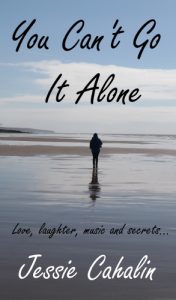
You Can’t Go It Alone
25th August 2018
WW2 is now considered historical and stories about that conflict historical adventures but there is the overtone – unique in the historical genre – of that setting’s impact on and causality relating to the present day. This month, we have been pleased to explore those possibilities within the context of best-selling author j j toner‘s exciting thriller, The Gingerbread Spy.
Welcome to An Author’s Mind, j j, we’re looking forward to learning more!

Can you briefly describe the story of The Gingerbread Spy?
j j toner: The Gingerbread Spy is Book 4 in my WW2 spy thriller series. Kurt Müller – a member, since Book1, of the German Resistance movement, The Black Orchestra – is in London, working with British Intelligence as a case officer for the Double Cross programme. This programme runs a number of German double agents sending misinformation to the Abwehr (German Military Intelligence). As D-Day approaches, a rogue agent surfaces with the call-sign Gingerbread, threatening the whole deception plan. When Kurt discovers that he is a suspect, he sets out to silence this Gingerbread spy in order to clear his name and save Operation Overlord.
Lizzie: People say all fiction is autobiographical. Have you based this book on a formative experience?
j j toner: Not at all. It’s a pure product of my imagination.
Lizzie: Is there an important theme (or themes) that the story illustrates?
j j toner: All the books in the series carry the theme that very few of the German population were Nazis or should be held responsible for the horrors of the Nazi regime.
Lizzie: An important point! Who are the heroes? Who are the villains? And why?
j j toner: There are two heroes in this book, Kurt and his girlfriend, Lina. Between them they unmask the Gingerbread spy. The villains are more difficult to spot, and some are only implicated through the lens of subsequent history.
Lizzie: Do the characters change?
j j toner: Yes. At the start of the book, Kurt and Lina are living together and Lina is bullied by her workmates. Kurt is riddled with shame and guilt, as he loves another. By the end of the book, Lina overcomes the bullies and shakes free of Kurt. Kurt makes his peace with his true love.
Lizzie: Does your main character undergo a transformation?
j j toner: This is tricky. His major transformation was in Book1, when he went from dutiful Abwehr officer to convinced anti-Nazi member of the Black Orchestra. There are personal transformations in the other books, but they are more subtle.
Lizzie: Which character would you most like to invite to dinner this evening and why? Who would you invite too? What would you hope to learn?
j j toner: I’d invite Lina. Her story is unfulfilled, but full of promise. I’d love to see how she turned out. Also, I’d invite Walter Schellenberg, the head of the SD. He was a slippery customer, who escaped the gallows by giving evidence against the other Nazis. I’d like to understand his true motivation.
Lizzie: Where did your research take you?
j j toner: Lisbon, Portugal, a beautiful city of hills and valleys.
Lizzie: What was the inspiration for writing this book series?
j j toner: The inspiration for the series and the idea of senior members of the Abwehr working against Hitler, came from reading Irish Secrets, German Espionage in Wartime Ireland 1939-1945 by Mark M. Hull, Irish Academic Press, 2003, ISBN 0-7165-2756-1
Lizzie: How does this book fit into the series?
j j toner: The story of the series follows the progress of the Second World War and this book ends in March 1944.
Lizzie: Why did you use historical fiction as a preferred genre?
j j toner: WW2 provides a ready-made canvas on which to hang a story. And if, as they say, a story needs conflict where better to find that?
Lizzie: What’s next?
j j toner: I have plans for a fifth book in the series, but my wife wants me to stop writing. We can’t afford a divorce!
Thank you for your rapid-fire answers, j j! These are highly appropriate for a man/writer of action!
If you’d like to learn more about jj toner, please see his Amazon author page. You can also read reviews of the series on Goodreads
And here – from Goodreads – is his short biography:
Born: Dublin, Ireland
Website: http://www.jjtoner.com/
Twitter: JJToner_YA
Genre: Mystery & Thrillers, Historical Fiction, Science Fiction & Fantasy
Influences : Douglas Adams, Robert Harris, Chuck Wendig, James Thurber, RA Lafferty …
URL https://www.goodreads.com/JJToner
After 27 years working with computers in a variety of industries: Oil exploration, pharma, hospitals, manufacturing, shipping etc., I retired early and began to write. I’ve been writing full time since 2007, and have completed hundreds of short stories and self-published 7 novels.

22nd July 2018
Another exciting guest! This month, I welcome psychological thriller writer Annie Weir to An Author’s Mind. We’re grateful to all our authors for taking time out to discuss their craft with us and no less grateful to Annie who in addition to writing her novels also runs a training company, IVITA Learning, in Cumbria. This is proof that if you want to write that novel, you’ll find the time! So, welcome Annie!

Annie: Thank you, Lizzie, and thank you for asking me along!
Lizzie: You’ve chosen to discuss your debut novel. Can you briefly describe the story of Judith Wants to be Your Friend?
Annie: It’s all contained in the strap-line, of course. If Judith wants to be someone’s friend, she makes it happen. This is the story of how she does that, with what results.
Lizzie: JWTBYF is your first novel and the product of a lifetime’s secret ambition So which three words describe how you feel, having published ‘Judith wants to be your friend’?
Annie: Yes of course.
- Proud – that I was able to bring 85000 words into a story that people have enjoyed reading.
- Thrilled – to see it in print.
- Ready – to writer another psychological thriller
Lizzie: How would you describe the genre of this book, if any?
Annie: My tutor at University of Cumbria described it as a ‘literary novel with psychological undertones’. I thought that sounded wonderful, but I soon learned that Waterstones doesn’t have a shelf for that type of book. I was advised by someone at The Literary Consultancy to call it a ‘psychological thriller’ so I took the advice of the experts.
Lizzie: Were you influenced by other writers or novels you’ve read? What’s the same? What’s different?
Annie: I was most influenced by four books in this genre:
- Notes on a scandalby Zoe Heller
- Enduring loveby Ian McEwan
- Englebyby Sebastian Faulks
- When will there be good news?by Kate Atkinson
They all involve people who behave strangely and who impose themselves on other people’s lives, affecting them profoundly. In each of the books, the person acting strangely has been influenced by different things causing them to be the way they are. In the case of Judith wants to be your friend, it isn’t clear why Judith behaves the way she does. There are hints about her relationship with her parents being different to that of her sister as they were growing up, and also hints about a good friend who had moved away suddenly. I have been asked for a prequel to make it clearer.
Lizzie: Is there an important theme that this story illustrates?
Annie: The theme is that unless we reflect on our past experiences, and especially mistakes, that our personal history can repeat itself.
Lizzie: Who are the heroes? Who are the villains? And why?
Annie: Well,
- Judith, herself, is the obvious villain although you do wonder why she is the way she is. Some reviews have said that they warmed to her through the story and felt sorry for her at the end.
- Chloe’s friend, Louise, lets local gossip influence her feelings towards Judith and influences Chloe who is nervous of relationships.
- Judith’s sister is the obvious hero. She is endlessly patient and trying to care for all the members of the family. Having said that, she isn’t a ‘goody-goody’, and I like her.
Lizzie: Do the characters change?
Annie: Judith finally changes, but it is a difficult journey that leads to her accepting herself and trusting her family. I am confident she won’t make the same mistakes again…
Lizzie: What is the most significant event for you in the story and why?
Annie: When Judith is having dinner with her boyfriend, one of the managers at the supermarket, he starts to talk about what has happened at work. Judith realises that she has taken her eye off the ball and landed a work colleague in a lot of trouble. She suddenly realises how much she has started to enjoy her life for the first time in a long time, and how much she has got to lose.
Lizzie: What moment in the novel do you like best?
Annie: My favourite moment is when Judith’s recent past catches up with her, and she has nowhere to hide. I love how the strands of the story come together and the personalities of the people in the store manager’s office come through clearly. It is also what pushes her to make changes in her relationship with her sister and niece.
Lizzie: What are the ‘unanswered questions’?
Annie:
- To me, the main unanswered question is about why Judith is the way she is. I hinted at it rather than explained. There may be another book there!
- A review on Amazon suggested there was a line of police enquiry that hadn’t been completed but an accountant-friend of mine assured me that the money wouldn’t be able to be traced.
Lizzie: People say all fiction is autobiographical. How much of Annie Weir is in Judith Dillon?
Annie: There’s a story I tell at the start of giving an author talk. It goes something like this:
I had a phone call from my twenty-something son about two months after Judith wants to be Your Friend was published.
Him: So, Mum – I mean so, Mam, have you ever been in the situation where you were so fed up with a conversation at work that you made up a lie about yourself? Then had to carry it on?
Me: No.
Him: Have you ever been really cross with someone at work and did something to them that you later regretted?
Me: No.
Him: Have you ever used someone at work to get what you want – just to spite someone else?
Me: (Getting worried about what on Earth he had been doing and saying at work) Look, darling, just tell me what’s happened, and we’ll come up with how you can sort it out.
Him: I’m not talking about me. I’m asking you if you’re Judith!
When I denied it, he started listing the similarities between us, starting with my southern upbringing which meant he wasn’t allowed to call me ‘Mam’. He does, by the way, to wind me up.
Anyway, I say again, no, I am not Judith.
But I do have a very dry sense of humour, and although many people don’t find the book funny, I think that it comes out in Judith’s private thoughts.
Lizzie; Thank you, Annie. I suspect that’s got us all wondering about everything!
Annie Weir’s first novel, Judith Wants to be Your Friend came about after many years of writing in secret. Then, in 2009, she decided to give writing ‘a proper go’, and in 2011, completed an MA in Creative Writing at the University of Cumbria. She is very proud of the fact that Judith Wants to be Your Friend, set mainly in Carlisle, has sold over 5000 copies. And she continues to write books, to support people starting their own business in Cumbria, and to run her own training company, IVITA Learning.
To find out more about Annie Weir, see
www.facebook.com/JudithWantsToBeYourFriend
www.twitter.com/annieweirauthor
To buy Judith Wants to be Your Friend:
19th July 2018
Coming soon – pyschological thriller writer Annie Weir will explain when literary fiction is not literary fiction. In short, it seems, it’s when a bookshop says it isn’t! But Annie will give us this and other insights in her interview for our An Author’s Mind blog! Watch this space!
21st June 2018

This month’s guest is the lovely Denitta Ward who has travelled a long way from her Rocky Mountain hideout in Kansas, USA, to tell us about her new novel, Somewhere Still. An historical novelist, she is particularly interested in how women survive and thrive in changing times. (This is a theme I love to explore too!) So, without further ado, welcome, Denitta!
Denitta: Delighted to be here, Lizzie, and to have this opportunity to talk about my work.
Lizzie: Can you briefly describe the story of Somewhere Still?

Denitta: Somewhere Still is a portrait of a young woman making her way in an era of opulence and abundance, at a time of great division and separation. It teems with resilient characters and takes you back to the Roaring Twenties to a city known as ‘Paris on the Plains’, alive with jazz clubs, speakeasies, and a burgeoning Prohibition bootleg trade. This time and place also deliver a rich tale of women’s social groups changing their corner of the world, the birth of baseball’s Negro League, and fast changes that bring traditional social mores into question. It was a time when the rules were clear and made to be broken.
From the day Jean Ball lands a job at the elegant Empire hotel, she quickly learns the secrets of the entitled class. Dazzled by a Roaring Twenties society on the cusp of radical change, this naive and innocent young woman finds herself dancing, bobbing her hair, and falling for Elden Whitcomb, the handsome son of the wealthy hotel owner. The stakes rise when the Whitcombs’ powerful secrets are revealed and loving Elden comes at a price – one that may be too high for Jean to pay.
Shattered and alone, Jean’s in the battle of her life in a city alive with romance, smoky speakeasies, jazz music and scandal, but divided by race and class. With the help and encouragement of influential women, Jean may find what she has always needed, though her choices could echo through generations. But will the man she trusted and so fiercely loves redeem himself?
Lizzie: What is the most significant event for you in the story of Somewhere Still & why?
Denitta: There are some surprises in the book that I can’t give away. I am disappointed when spoilers leak out and I never skip to the end of a book myself, so the most significant events are a secret. But, there are scandalous secrets revealed that tell you the motivations for some of the characters’ behavior. Elden’s parents, for example, have very rigid thinking and great fear of crossing social classes. Once you know their secrets, you can see the tension our male lead carries with him every day. The poor boy! I also love/hate the scenes where you get a sense of the terrible racial divide in America in the 1920s. Many white people then lived by simplistic ideas of “truth” that were so wrong, and that were just starting to be questioned. When you see this in the book, you can also feel the hope that these beliefs will be broken down by individuals who will make a conscious choice to reach out across race and class to one another.
Lizzie: Is there an important theme (or themes) that this story illustrates?
Denitta: All of my historical fiction features young women coming of age in times of social and cultural turmoil. I think it is fascinating how we raise young women with certain rules, and I know we all recall the rules our parents and grandparents tried to instill in us. In times of social and economic change, as we go out into the world, those rules don’t always seem to apply. How they adapt and find their own resilience makes for wonderful tension and great story-telling.
Lizzie: What did you learn about change and social classes in this book?
Denitta: I love questions. Somewhere Still is ALL about change — social, racial, cultural and economic. Women had just gotten the right to vote in the U.S. and the activism that resulted in those rights continued. Women had figured out the power of collective action and group formation. The book tells the true story of the women’s Consumer League that was active in 1921 in Kansas City. It was a time when barriers were being crushed and opportunities opened.
Lizzie: Who is/are the hero(es)? Who are the villains? And why?
Denitta: The biggest heroes are some of the supporting characters: Otis and Abby and Michele Hayward, all who do the right thing, even when they have nothing to gain. You see the power of one individual to make the good choice, the right choice, the ethical choice, in the moment and to take action. And that makes all the difference – in ways the main characters themselves may never have imagined. I hope seeing those choices and their impacts provides a lasting lesson readers will carry with them and pass on. The villians are those who hold fast to prejudices – of race, gender and class. We can understand these characters, and appreciate that they are grasping for a sense of normalcy that is old-fashioned and, ultimately, not healthy for themselves or society. The 1920s were a critical turning point in American society, and even worldwide, and we see characters who are not yet ready to move forward.
Lizzie: Do the characters change?
Denitta:I felt the biggest change was for the character who was hardest for me to write, Elden, the male protagonist. You see and feel his journey, and at the end you can understand all the forces that held him back and controlled his choices, and you get to see how he won over those forces. For Jean, her life is forever changed and we feel hope and love in whatever comes next for her. Even for Elden’s parents, we can see the change and how they grow and evolve.
Lizzie: Which character would you most like to invite to dinner this evening and why? Who would you invite too? What would you hope to learn?
Denitta: I would invite Mrs. Hayward Parker (Michele) to dinner in a heartbeat. She is forward-thinking and a can-do person. Never comfortable with the status quo, she will make things happen – even when others would turn away. I love that in her and I value that in any person. I’d want to know about her early life. She and Elden’s mother had so much in common but they turned out as polar opposites. I wonder why and how Mrs. Parker found and kept her strength of conviction, and I’d love to chat with her about it. I’d also like to share with her where women have progressed to in 2018, and the #metoo movement. I know she would have thoughtful insights to share. #Metoo didn’t start in 2018, you know.
Lizzie: Where did your research take you?
Denitta: I grew up in a little town outside of Kansas City and the story probably began when I first set foot in the city’s famed Savoy Restaurant and Hotel back in 1968, when I was 5. The grandeur. The history. I could feel it. I remember it still. Then fifty years passed and finally the story came to life. I did much of my research online and also had a wonderful trip back to Kansas City with my daughter and mother. Kansas City is beautiful. It’s called “Paris on the Plains” for a reason – the Plaza is breathtaking, especially when it’s lit up over the holiday season, and the city has so many ornate fountains and parks. I hope readers will feel my love for this city. I wanted to bring the city to life in Somewhere Still.
Lizzie: What moments in the novel do you like best?
Denitta: The Christmas Dinner scene was such a fun scene to write. Jean is meeting Elden’s parents for the first time. Oh, the drama and the feelings and the glasses smashing against the wall. I am quiet and shy away from any drama in my personal life, but I let it all loose in that chapter.
I love the scene where we learn why Otis is so tender and caring with Jean. That tore me up and was inspired by a conversation with the consultant who reviewed the book for unconscious bias. He wanted to know more about Otis, and with just a few sentences I was able to add that to the book.
There were other scenes that if I shared would spoil plot secrets — you’ll know them when you read the book — they wrenched my heart and it took time to recover from writing them. When devastating things happen in novels, I now understand that the biggest toll is taken on the author. We have to love our characters, heart and soul, to bring them to life. To see them in pain or hurt is so very hard.
Lizzie: I agree. Have you compared Somewhere Still to any other novels you’ve read? What’s the same? What’s different?
Denitta: Readers have and it’s such an honor. I hope those who loved Before We Were Yours, The Great Gatsby, and To Kill A Mockingbird will feel and enjoy the sense of time and place, as well as understand the thin reed upon which lives hung back in the Roaring ’20s. We’re coming upon the 100th year anniversary of the Roaring Twenties and I hope this era captures the imagination of readers worldwide.
Lizzie: What is your next book?
Denitta: There are two. Prohibition Cocktails is now out. Here are the blurb and a link.
It has a promotion in the UK where it will be 99 cents – July 14-21. — though I don’t think that means a thing for your Australian or US readership.
https://www.amazon.com/dp/B07BHF1NSJ. The book provides historical background on Prohibition and the history, secrets & recipes of 21 of the most popular cocktails of the Prohibition Era. It’s a nice companion to Somewhere Still.
The next novel in the series, Somewhere Else, is in the works. This is a coming of age story set in Havana in the weeks before Batista falls and Castro comes to power. It is written but needs to be pulled apart and put back together – which I truly enjoy!
Somewhere Still is available from Amazon, Barnes & Noble.com and from Bookstores.

Denitta’s story:
In addition to writing the Somewhere story series, Denitta holds a Juris Doctorate from Georgetown University Law and obtained her undergraduate degree in Women’s Studies and Political Science from the University of Kansas. She is a member of the Women’s Fiction Writers Association, the Historical Novel Society, and Rocky Mountain Fiction Writers. To learn more about her, see her website, and/or follow her on Facebook, Twitter and Goodreads.

24th May 2018
I’m delighted to have the opportunity this month to introduce Rosalind Winter! Rosalind is an historical author with a difference. She is adept at playing with the ‘time-slip’ concept and producing truly original stories! Read on . . .
Good Morning, Rosalind! A very warm welcome to my An Author’s Mind blog! Let’s get started straight away.
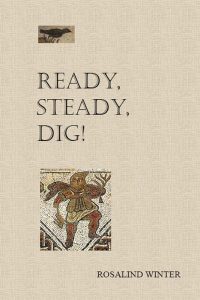
Could you briefly describe for our readers the story of Ready, Steady, Dig!?
Roman Britain in the first quarter of the fifth century AD: the legions have withdrawn to protect the Mother City of Rome. With marauding Saxons now terrorising the countryside, a wealthy Romano-Briton leaves his Cotswold villa for the safety of a nearby town, but first (as we know many did) he buries the bulk of his treasures to be retrieved when peace returns. He never comes back. Fast-forward to 1998, when the ruins of the villa come to the attention of the popular TV archaeology programme Ready, Steady, Dig! (Any resemblance to ITV’s Time Team is not in the least coincidental). The novel relates the archaeologists’ efforts to excavate the site, which are seriously hampered by the villa’s Lares and Penates, the little household gods. Sixteen hundred years ago they were ordered to guard their master’s buried treasure, and they can see absolutely no reason why they should stop now.
How would you describe the genre of this book, if any?
Comedy. Comedy is my default setting: I’m currently writing what was intended to be an entirely serious prequel to Ready, Steady, Dig! and almost from the start I have been finding irresistible (to me) comic touches. I suppose this mirrors my experience of life in general. I can generally find the funny – or at least the absurd – side of almost any situation.
Which leads me directly to … Have you compared Ready, Steady, Dig! to any other novels you’ve read? What’s the same? What’s different?
Terry Pratchett is my literary hero. I love his sense of the ridiculous, the way in which he takes situations and ideas to gloriously absurd but somehow entirely logical conclusions. A couple of years after finishing Ready, Steady, Dig! I read his Small Gods, which has a similar basic premise: what happens to the gods when there’s no one left who believes in them? I hugely admire Pratchett’s command of language, which I think is unsurpassed in comic fiction, at least in his early and middle period work. Sadly towards the end, when Alzheimers began to take hold, I find that although the ideas are still there and still as brilliant and original as ever, he often strains too much for comic effect, and sometimes fails. Finally I enjoy the way that Pratchett can move in an instant from the comic to the really rather moving: anyone who doesn’t shed a few tears towards the end of Reaper Man has no heart! This is something I aim for in my own stories, and I think this is what separates Pratchett’s work from that of other comic writers like Tom Holt: Holt is very, very funny, but I can’t remember ever really caring about any of his characters, no matter how superficially engaging they may be.
People say that all fiction is autobiographical. Have you based Ready, Steady, Dig! on a formative experience?
Chedworth Roman villa is the model for Rooks Ridge, and it’s a place I have known for as long as I can remember. One of my uncles came from Chedworth, and indeed his grandfather took part in the original excavations there. It was on a visit to Chedworth that I started to think about the beliefs of its Roman occupants. They would have been Christian, of course, by the date the villa was built, but did they entirely abandon the beliefs of ancient Rome, or were these perhaps gently relegated from formal religion to localised superstition? When Christianity was imposed by the state, would ordinary Romans really have discarded their Lares and Penates, their little household gods, and would they really have ceased to acknowledge the Genius Loci, the Spirit of Place? I think many would have continued to keep the Lares and Penates as talismans or good luck pieces, silently acknowledged even though no longer actively worshipped. I think most of us have at one time or another been aware of what I would identify as a Genius Loci: a very special feeling in a particular place, something you can’t put into words, but which raises the hairs on the back of your neck, and makes you cautious about turning around too quickly, in case you should catch a glimpse of – what? And one thinks of people today who leave flowers and teddies at the site of a fatal road accident, who set an extra place at table on the anniversary of a loved one’s death, or who toss coins into fountains and springs for good luck. Even people without any acknowledged religious belief often feel compelled to do these things; and why should the Romans have been any different? The idea of the Lares and Penates, the little household gods, particularly appealed to me. I have always been a keen student of history, but what really engages my interest is not monarchs, wars, or politics, but the intimate details of ordinary people’s lives: how they lived, what they ate and wore, and what they really believed in. What the early Romans very much believed in was a host of little supernatural beings who looked after every aspect of their households: there wasn’t just Janus, god of doorways, there was a Lar of the Hinges, a Lar of the Door Leaves, and a Lar of the Lintels. There was a Lar whose sole concern was the Broom, another for Pots and Jars, another for Platters, a pair of them for Little Dishes, and yet another for Cutlery. The list is a long one, and that’s just those we know about. I find the whole concept of the Lares and Penates really very endearing in all its domestic detail, and I simply couldn’t resist writing about them.
Who is your target readership?
I don’t have one. I write purely for my own pleasure, so the rise of self-publishing over recent years has suited me down to the ground. On the one occasion when I did have a novel accepted by a commercial publisher, I eventually reluctantly declined the offer because it was dependent on some fundamental edits that I simply could not accept. If pressed, I will say that my book is aimed at older children and adults, and something I do find mildly irritating is the occasional reviewer who says the book is “too difficult” for older children. I was reading H G Wells and Jules Verne when I was eight, and although I’m sure quite a lot of what I read then went right over my head, I don’t think that matters: if children aren’t challenged by their reading, and only read “age appropriate” books, then how are they to develop their tastes and increase their knowledge and appreciation of language?
What are your processes?
The process for me always starts with an abstract idea rather than a character. I always know how the story will begin and end, and there will be some key scenes floating around in my head which I like to get on paper as soon as possible. So I’m constantly dodging backwards and forwards, and that means I have to do a huge amount of re-writing as the book takes shape and the detailed plot develops. I don’t think this would work at all for a character-driven novel, but mine are all very much plot-driven. My characters very quickly take on lives of their own, and frequently surprise me: for example, when I started writing Ready, Steady, Dig! I had absolutely no idea that a low-key gay romance would emerge in the background. I didn’t even realise that the two characters involved were gay until about halfway through writing; then when I looked back, I found they’d been hinting at this all along. After that, what could I do but give them their own minor plot strand, and of course the strong presumption of an eventual happy outcome? I like to think that my way of building a character mirrors what generally happens in real life. When you first meet someone you know very little about them apart from their name and what they look like, and only gradually will you come to understand how they think and feel and how they are likely to behave.

What are your passions?
My passions are: social history, folklore, mythology, language, and especially names. Most of the names in my novels are indications, sometimes obvious, sometimes much less so, of significant characteristics. Several readers have spotted that although Graham appears to be a mildly comic and wholly inappropriate name for a beautiful white stag, it’s actually quite the opposite, since it derives from the Anglo-Saxon graeg hama, “grey coat.” A lot of readers have noticed a number of covert Beowulf references in my nomenclature (the reason for these becomes clearer in the prequel which I’m currently writing), although I don’t think anyone has yet identified Grendel’s descendent in Ready, Steady, Dig!, nor realised what a very nasty surprise is likely to be lurking in Harnstone Lane. My interest in nomenclature, why people, places and things are called what they are, began a very long time ago. I still remember my great satisfaction when I discovered that the apparently meaningless bird name “wheatear” has nothing to do with wheat or ears, but is in fact a bowdlerisation of the Anglo-Saxon hwit earse, and refers to the bird’s most salient characteristic, its white rump.
Is there an important theme (or themes) that the story of Ready, Steady, Dig! illustrates?
I’m afraid not! I don’t aspire to create literature: I just like writing stories.
Which character would you most like to invite to dinner this evening and why? Who would you invite too? What would you hope to learn?
The Lares and Penates – just imagine the information they could provide about everyday life in a Romano-British villa. And with such an opportunity for learning so much that now we can only guess at, it would be very unkind not to invite the splendid Mary Beard to join us!
What moments in the novel do you like best?
The Epilogue. With me, it’s almost always the Epilogue, and I tend to spend a quite disproportionate amount of time on this. It usually gets drafted very early on, and then I constantly re-visit and re-shape it as I write the rest of the novel. I like to aim for a hint of sadness in a beautiful, peaceful setting, with a final line that lifts the spirits. In Ready, Steady, Dig! it’s a lark ascending. I hope I manage to avoid sentimentality – difficult, because I have to aim very close in order to get the effect I want!
Thank you so much, Rosalind, for such an interesting and absorbing interview. Your own story reads very much like a novel too.
Rosalind Winter was born in Shillong, Assam, and educated in England, where she read English Language & Literature at Bedford College, University of London, and gained a Masters in Early English at Queen Mary College. In 1974, she received my PhD for her thesis on Beowulf and the Finsburg Fragment.
In 2006, Rosalind took early retirement, having worked in university education (University College, Cork, and Aston University), and at the Royal Shakespeare Theatre in Stratford-upon-Avon. She followed this, as Press and Education Officer for the National Trust in Cornwall, and for the Cornwall and Isles of Scilly Local Medical Committee. From 1982 to 1989 she also served in the Territorial Army with 67 (The Queen’s Own Warwickshire and Worcestershire Yeomanry) Signal Squadron (Volunteers).

Rosalind’s Bibliography!
In 2008, her first novel, the ever-popular Ready, Steady, Dig! was published, followed in 2009 by its sequel, Gnome or Mr Nice Guy. The following year I produced a book of short stories for children, The Mice of St Goran, which was published in aid of St Goran Bell Fund. I then took some time off from my own writing to edit and publish a two-volume novel written by a dear friend, the late Lesley J Nickell, Butterfly: Painted Lady (2013) and Butterfly: Mourning Cloak (2016), set in the English Civil War and based on the life of Lady Mary Villiers. In 2014/5 I encouraged my mother to mark her 99th birthday by writing her memoirs, which I have now edited and published under the title Plucking the Moon from the Bottom of the Sea: The Life and Times of Audrey Winter. The book covers her childhood in Bristol in the 1920s, wartime service in the National Auxiliary Fire Service, and life as a memsahib in Assam in the final days of the British Raj.
Rosalind also writes short stories, for both adults and children, which have appeared in a number of anthologies, and has been working intermittently on a collection of short stories set in a Cornish fishing village. At the same time,she is working on a prequel to Ready, Steady, Dig! set in Roman Britain, which it is hoped will appear in time for Christmas this year.
If you want to find out more about Rosalind and to buy Rosalind’s books, please see:
Facebook link https://www.facebook.com/rosalind.winter
Twitter link https://twitter.com/RosalindWinter
FeedARead https://www.feedaread.com/search/books.aspx?keywords=Rosalind%20Winter
21st May 2018
Coming soon – watch this space for an historical novelist with a difference! Author Rosalind Winter will be telling the tale of how she created ‘Ready, Steady, Dig!‘ – a time- slip novel that comes forward in time!
19th April 2018
This month’s guest is popular author, Cath Cole, whose debut novel, Home from Home, has reached some soaring heights in the charts. Welcome, Cath! Those of us who love a nursing tale, would love to know what was in your mind when you wrote this, your first novel!
Would you start by – briefly – describing the story of Home from Home?
Thank you, Lizzie, for inviting me. Yes, of course! Briefly, the lives of Theresa, Maggie, Jenny, Sarah and Chris are about to change forever as they start their nurse training at The Farnton School of Nursing in May 1966. They soon realise that they have much to learn about life, both on and off the hospital wards. A strong bond is formed as the young women face the challenges presented by families, boyfriends and their nursing responsibilities. Friendships are tested as the young nurses experience the joys and heartbreaks of growing up. But for each of them, for different reasons, the hospitals will become their home from home.
It is said that all fiction is autobiographical. Is Home from Home based on your experiences?
Yes, in that I started my State Registered Nurse (SRN) training in May 1964. I trained at Bolton School of Nursing which is situated in Farnworth. The practical training was between two hospitals one in the same grounds as the School of Nursing – The General. The other in Bolton – The Infirmary. I did not want the location to be readily identifiable as Bolton given that I used real incidents in the narrative, hence the setting is Farnton.
No, in that the five girls are fictitious. Readers ask which character is you. The answer is none. However, each character enjoys at least one social or nursing circumstance related to my personal or nursing experiences.
What is the most significant event in Home from Home and why?
Theresa Booth, the rebel, forms an unlikely bond with Miss Bennet one of the tutors. As her training progresses, against the odds, Theresa proves herself to be a bright, intelligent competent student who has the potential to be a talented nurse. In a heart to heart Miss Bennet recounts a story for her nurse tutor training when a fellow student who “spoke just like Princess Margaret,” told her “you know Bea, considering the way you speak, you really are quite bright.” ‘
The moral of the tale for Nurse Booth is ‘Never be afraid to be yourself, always remember your roots and take strength from them but don’t hesitate to have the courage to move on.’ This is significant for me because a Princess Margaret speak-alike made the comment to me when I was training to be a nurse tutor. The incident in Home from Home is important to me, because no matter what I have achieved I, like Miss Bennet, take strength from remembering my working-class roots.
What did you learn about change and social class when writing this novel?
Change and social class are an underlying premise of Home from Home. The period of the novel 1966-69 in a northern working-class town was a period of change for the student nurses and their families. The Swinging Sixties took a long time to penetrate the home and professional lives of the girls. Their parents, and senior nursing staff, were comfortable with post-war values and attitudes relating to marriage, sex, and social and professional position. While the girls enjoy experiences that widened their personal and social horizons these often conflicted with the adults in their lives Four of the characters change from adolescents to young women, Chris is a mature entrant to nurse training. The achievement of State Registered Nurse training confers a professional qualification on girls who have been denied the experience of university. My SRN training has underpinned my subsequent professional success.
Where did the research for this novel take you?
Back to nursing text books and back to the General and a walk down memory lane. Sadly, the Infirmary, where I was a cadet and staff nurse closed in the early 1990s.
What moments do you like best?
A difficult question. Can I have two? One is when Maggie is sent to fetch a unit of blood from the pathology lab. Her colleague, on nights, tells her a ghost story and then sends her through the deserted hospital and up a spooky side corridor leading to the pathology laboratory past the mortuary and into the blood bank. She is scared yet aware that she needs to return with her valuable cargo of a glass jar containing the life-saving blood intact. The other is during obstetric training when a zealot for breastfeeding of a maternity sister tells the student nurses “There are four types of breasts and they can all do the job….Whoopers, Doopers, Droopers, and Dead Dog’s Ears.” A true incident and one my nursing friends and I enjoy retelling when we get together. It is also a classification my husband uses when we are on holiday and he is people watching on a beach or round a swimming pool.
Thank you, Cath, for a very entertaining author interview!
Home from Home is available from Amazon £1.99 kindle addition. £7.99 paperback
For those who would like to know more, see:
But in brief, Cath Cole had a working-class upbringing in a northern town. She trained as a nurse and health visitor and eventually as a lecturer and nurse tutor. She had a successful career in further education, becoming the principal of a further education college. After rescuing a failing college, she was awarded the OBE. Denied the opportunity of university, nurse training served to give her the key to a professional life as well as the grit and determination to succeed.
She is happily married with a son and two grandchildren. She was awarded a Master of Arts (Creative Writing) from Edge Hill University in 2013. Her first novel Home from Home was published in April 2015. It enjoys four stars on Amazon and has had seventy-four reviews. Cath travels, enjoys the theatre, reads and spends time with family and friends. She has recently been appointed Chair of Trustees for Chorley Football Club Community Trust.
12th April 2018
Just a note to say you can meet the Author of Home from Home, in my series, An Author’s Mind, next week. (19.04.2018) This is all about contemporary fiction meeting a nursing tale with a difference from popular writer, Cath Cole.
An Author’s Mind – posted on March 22nd 2018

This month, I’m delighted to welcome British independent author, Tim Walker. Welcome to the An Author’s Mind slot, Tim. We’re looking forward to hearing about your recently published novel and any works in progress. So many of us love Arthurian legend!
Thanks for inviting me. My new historical novel, published in March 2018, is Uther’s Destiny. Although the third book in A Light in the Dark Ages series, it can be read as a standalone, as it charts the imagined kingship of High King Uther Pendragon of the Britons in the second half of the Fifth Century. He is perhaps better known as the father of King Arthur.
Can you briefly describe the story of ‘Uther’s Destiny’?
The story begins two years into Uther’s reign in the year 469 AD. He has succeeded his brother, Ambrosius Aurelianus, as high king of the Britons, and his main concern is to protect the boundaries of his kingdom – modern day England and Wales – from barbarian invaders. Uther’s destiny as a warrior-king seems set until his world is turned on its head when his desire to possess the beautiful wife of a noble, Ygerne, leads to conflict. Brittle alliances teeter on the brink of collapse as Uther doggedly pursues his quarry, oblivious to other pressing matters of state.
Court healer, and schemer, Merlyn, sees an opportunity in Uther’s lustful obsession to fulfill the prophetic visions that guide him. He is encouraged on his mission by druids who wish for a return to ancient ways and urge him on to protect the one destined to save the Britons from invaders and lead them to a time of peace and prosperity. Merlyn must use his wisdom and guile to thwart the machinations of an enemy intent on foiling his plans.
Uther is challenged to rise above his domestic problems and raise an army to oppose a gathering Saxon force. In a climactic moment, the two armies meet in a battle that will decide the fate of the island.
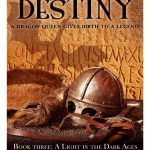
What was your inspiration for writing this book series?
On a summer’s day in 2015 I stood on a grassy meadow at the site of former Roman town Calleva Atrebatum (known as Silchester in the Middle Ages) in North Hampshire, trying to imagine what it would have been like at the time the Romans evacuated between 409-410 AD. Unlike other Roman towns, this one was largely abandoned some time after the Romans left, and therefore is a green field site for archaeological excavation. The abandonment took place gradually over a few hundred years, for reasons that are the subject of speculation.
It was the site of the main village of the Atrebates tribe at the time of the Roman occupation that took place after 49 AD, when the legions of General Aulus Paulinius (on behalf of the Emperor Claudius) worked their way across the island. The Atrebates were subdued and became a ‘client kingdom’ in the same way as the Trinovantes and Iceni had to the east. The stone-walled town the Romans built was named ‘Calleva Atrebatum’ meaning ‘Wooded Place of the Atrebates’ – showing a desire by the Romans at conciliation and aimed at getting the cooperation of their new subjects.
I had read Rosemary Sutcliffe’s novel The Eagle of the Ninth at school, and was intrigued to learn that the discovery of a bronze eagle (on display in the Reading Museum) buried in what would later be identified as the Forum in Calleva, was her inspiration. I was also interested in the Arthurian legend, and pondered the historical connection between the Romans leaving (and taking their record clerks with them) and the start of what became known as The Dark Ages – a time from which few written records have survived to tell us what actually happened and how the Britons organised themselves after four hundred years of living under Roman rule.
I decided to research this period and write an historical series that aimed to connect the end of Roman rule to the Arthurian legend and try to pitch it to readers as a believable alt-history. It doesn’t help that the originator of the Arthurian legend is the largely discredited Geoffrey of Monmouth, writing around 1136. His epic work, Historia Regum Britanniae – The History of the Kings of Britain – includes the first full account of the Uther Pendragon and King Arthur stories (aside from brief mentions of Arthur in earlier chronicles). His work is dismissed as ‘history’ by historians due to his bizarre habit of supplementing gaps in his research with fanciful tales and his dubious practice of re-arranging historical sequence to suit the purposes of his narrative. However, there is evidence that he did extensive research and may have had access to a lost text upon which his accounts of Fifth and Sixth century events are based. His work is being re-appraised by some historians who now believe there is some merit in his creative approach to making a timeline of kings.
How does ‘Uther’s Destiny’ fit into the series?
Uther’s Destiny is the third and final installment, as I always intended to end with the coming of King Arthur. The series starts with Abandoned! This is a novella set at the time the Romans left Britannia, around the year 410 AD. It was in this year that the Emperor Honorious advised Briton administrators to ‘look to your own defence’. My story centres on the fictional character of Marcus, a half-Roman auxiliary cavalry unit commander, based at Calleva Atrebatum. At the time the Roman garrison departs, he is out patrolling the south coast, where he witnesses a large Saxon raiding party sack the port of Noviomagus (modern day Chichester). He returns to Calleva to report to his commander, only to find they have departed, and left written orders for him to follow them with his troops. Tribal leader, Vortimer, persuades him to remain and organise their defence against the roving Saxon warriors. In my story, Marcus adopts his Briton mother’s family name of ‘Pendragon’ to show his allegiance to the local cause.
The second book, Ambrosius: Last of the Romans, is set some thirty years later, around 440 AD. Roman tribune, Aurelius, raised by Marcus and his family in Calleva as an orphan, returns to Britannia from Gaul with a small army to challenge High King Vortigern, who has murdered his father, Constantine, and claimed the former Roman province as his kingdom. Aurelius is reunited with his adoptive brother, Uther, and together they lead an army against Vortigern. They succeed, and Aurelius adopts the name ‘Ambrosius’ (‘the Divine One’), becoming High King Ambrosius Aurelianus. The book charts his reign and his efforts to unite the Briton tribes in defence of the island. Uther’s Destiny continues the story, following the death of Ambrosius, and builds towards the coming of King Arthur.
Does your main character undergo a transformation?
I dreaded writing this book because I knew Uther would be a character I would struggle to warm to or sell to my readers as having any noble or virtuous characteristics. For me, it was an exercise in writing about a character that I don’t like. However, he has taken on the responsibility of kingship and knows the importance of firm leadership, and I decided to have him as a predictable, solid figure around whom the real drama, involving other characters, swirls. He is a rough, tough unsophisticated warrior who is happiest when in the saddle fighting his enemies. He is getting older and is concerned with two things – his lack of a male heir, and maintaining his ‘tough man’ image before his court, despite aches and pains and a growing belly. He is lonely since his wife, Jessica, died, and relies on the comfort of his daughter Morgana, and slaking his lust on serving girls.
His world is turned on its head when he sees and falls in love with the beautiful wife of one of his nobles – Ygerne. She feels powerless to repel his close attentions at a banquet and this brings Uther into conflict with her husband. This proves to be a pivotal moment in Uther’s kingship, as he stubbornly follows his lustful desire to its tragic conclusion. He is not transformed, rather he acts in a predictable manner that ultimately has repercussions for those around him, and presents an opportunity for one individual in particular. The characters revolve around Uther who is at the centre of a storm of his own making, and all must live with the consequences.
Why did you choose historical fiction as your preferred genre?
I think historical fiction chose me, in as much as I have an interest in history going back to my school days and have a journalistic background that makes me comfortable with doing research. When I left school in Liverpool, my first job was as a trainee reporter for a local newspaper. I was asked to research and write the history of a local grade I listed building that had recently changed hands, and I ended up spending weeks in the library uncovering a history that reflected the glory years of the city. It was serialised in the paper and published as a booklet later on.
When I started writing the short stories in 2014 that eventually formed my first book, Thames Valley Tales, I had unconsciously been drawn to a combination of current affairs, local news and local history as influences in my storytelling. This gave me the confidence to tackle a bigger project – researching and building an ‘alternative history’ of Britain in the Fifth Century. I had also discovered, as I approached my third age, a preference for fiction over non-fiction – it’s far more interesting, I feel, to build dramas around people and situations, and to locate them in a world of my choosing – in the past, present or future.
What’s next?
I’m still intrigued by the King Arthur legend, but put off writing about it (at least as a continuation of my series) because it has been done to death in books and film, and imbued with too many fantasy elements. However, I wrote a short story a couple of years ago about Arthur King – a talented schoolboy in a future Britain who wins a computer games competition and… the rest is yet to be conceived. But having written one dystopian novel already – Devil Gate Dawn – set in 2026, I can feel myself heading in that direction again, perhaps taking elements of the Arthurian legend with me.
Tim, that was a fascinating round-up of your achievements so far and a peek at where you hope to go next. Very Good Luck with your projects and thank you for joining us here on the blog.
 To buy A Light in the Dark Ages series:-
To buy A Light in the Dark Ages series:-
Abandoned! – http://myBook.to/Abandoned
Ambrosius: Last of the Romans – http://myBook.to/Ambrosius
Uther’s Destiny – http://myBook.to/Uther
To find out more about Tim, see
Author website: http://timwalkerwrites.co.uk
Facebook page: http://facebook.com/timwalkerwrites
Twitter: http://twitter.com/timwalker1666
Amazon Author Central: http://Author.to/TimWalkerWrites
An Author’s Mind: interviewing Jane Davis
I am delighted to begin an occasional series today, entitled ‘An Author’s Mind’. In this, authors and I will be exploring the intellectual prompts – and the passions – that stimulate an Author’s Mind. Something that fascinates me is that authors, whether writers of contemporary or historical fiction, often ask the same questions although the answers can be so very different. And I am particularly pleased to begin the series with a peep at the latest contemporary fiction novel by award-winning novelist, Jane Davis. During the excitements of publishing Smash all the Windows, Jane agreed to be interviewed for The Wolf of Dalriada‘s blog and I hope you’ll enjoy her honest and thoughtful responses to a fellow novelist’s questions!
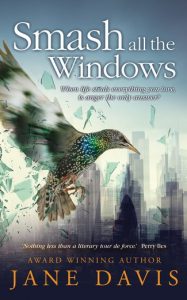
Welcome, Jane!
Can you briefly describe the story of Smash all the Windows?
For the families of the victims of the St Botolph and Old Billingsgate disaster, the undoing of a miscarriage of justice should be a cause for rejoicing. For more than thirteen years, the search for truth has eaten up everything. Marriages, families, health, careers and finances.
Finally, the coroner has ruled that the crowd did not contribute to their own deaths. Finally, now that lies have been unravelled and hypocrisies exposed, they can all get back to their lives.
If only it were that simple.
People say that all fiction is autobiographical. Have you based Smash all the Windows on a formative experience?
Actually, it was quite a recent experience! I think you always have to make it personal, so I combined two of my fears – travelling in rush hour by Tube, and escalators. Last year, I suffered a fall on my way to a book-reading in Covent Garden. I was overloaded, having just finished a day’s work in the city. I was carrying my laptop bag, my briefcase, plus a suitcase full of books. The escalator I would normally have used was out of order. Instead we were diverted to one that was obviously much steeper but I wasn’t prepared for how fast it was. I pushed my suitcase in front of me while holding onto the handle and stepped on. The case, which was only one step in front of my feet, literally dragged me off-balance. Fortunately, there was no one directly in front of me, and a few bruises and a pair of laddered lights aside, I escaped unscathed. But I can still blink and see the moment I knew I was about to fall and the recognition that there wasn’t a damned thing I could do about it.
What is the most significant event for you in the story of Smash all the Windowsand why?
In a way this was an odd piece of story-telling, because the reader knows right at the outset what the key event is. The St Botolph and Old Billingsgate disaster was a large-scale disaster that resulted in the death of fifty-eight commuters. The challenge was to show the impact of the event on different individuals and their families, who have re-lived it each day of the eighteen-month long inquest. Because the accident takes place in an underground station, we see the various characters travelling towards it. I tried to create a sense of real-time and urgency, despite the fact that the reader knows the accident happened fourteen years in the past.
Is there an important theme (or themes) that this story illustrates?
In fiction, there’s a temptation to try to undo the wrongs of the real world by applying logic, assuming that there is a single ‘truth’. In Smash All the Windows, I used several points of view, so that I could explore different reactions to and opposing viewpoints on the same subject. Who are the victims? Should individuals have been held accountable when large-scale accidents occur, or does this prevent the identification of the factors that create circumstances that allowed accidents to happen? How should families and friends of victims be treated when they’re searching for or identifying loved ones? Should those same friends and family members be allowed to participate fully in inquests? Of course, many of these themes were dealt with in great detail in the verdict of the second Hillsborough inquest, which is what set me on course for writing this novel. But it’s not a book about technicalities. It’s about human resilience, healing and art.
What did you learn about change and social classes in this book?
I learned that large-scale disasters are indiscriminate.
Who is/are the hero(es)? Who are the villains? And why?
Given that each character gets up day after day and faces the world, despite everything they’ve lost, all of the characters are heroic. It’s just that some forms of heroism are more obvious than others.
Gina Wicker didn’t only lose a son. She lost her idea of who he was – of who she herself was. She was not, as she had hoped, a good mother, and this knowledge led to a downward spiral of self-destruction. Is it any wonder that her daughter Tamsin is increasingly distant?
Tamsin finds herself at a crossroads. Almost twenty-seven years old, she’s still living at home with her alcoholic mother. But how long will boyfriend Graham wait? And having lost so much of her teenage years, isn’t she entitled to a life of her own?
Maggie and Alan Chappel aren’t from London. When Alan decides that the best chance he has of healing his hidden wounds is by returning to his Northumberland hometown, Maggie comes under mounting pressure to explain her reluctance to go along with his plans.
On that fateful day, two generations of Donovan’s family were wiped out in an instant. Not only his daughter and future son-in-law, but his unborn grandson. He has another source of pain, less obvious. One he cannot discuss. Ever since the funeral, his wife Helene has turned her back on the world, refusing to leave the house. But surely, if he can raise money to build a monument, she might be persuaded…
Jules Roche, unwitting poster boy for the disaster, has reluctantly found fame with the sculptures he created from an outpouring of blind anger and unending sorrow. Now, in celebration of the verdict, Tate Modern wants to stage an exhibition of his work. Jules accepts – but on his terms. And art created from anger holds the power to shock.
Of all of the characters, I think it’s Eric who deserves to be singled out. When most injustices are overturned, there is usually an individual in the background. The one who realised that an injustice had been done and who then worked tirelessly behind the scenes in order to construct a case. With the Hillsborough disaster, it was Phil Scraton, professor of criminology, whose credentials lent weight to the families’ arguments. With St Botolph and Old Billingsgate it was Eric, a law student who is still some way from qualifying as a solicitor.
The outsider in the story, his arrival proves to be a turning point for families, who have all but given up in their search for justice. In the midst of all of the heartbreak and human reaction, the unseen suffering, the unnoticed agonies, his conviction reminds the families that they still have a little fight in them.
The difference between Phil Scraton and Eric is that the majority of people are unaware of the role Eric has played. Save for the families, his efforts go unacknowledged. And while that might seem to be another injustice, he isn’t someone who craves the limelight. In fact, the reverse is true.
As for the villains? That’s a far more difficult question to answer. In the end, I decided not to make anger the only answer. I made my book about ‘unblame’ rather than ‘blame’.
Do the characters change?
The lives of the families of the victims have already changed in ways that they could never have imagined. Mostly, it’s a story about gradual healing, but there are breakthroughs and insights, some of which are critical. Maggie, in particular, has felt guilty about getting on with her own life. She has worried that this would mean forgetting. But Jules delivers a simple concept in a single sentence and you just know that it will kick-start the process of change.
Which character would you most like to invite to dinner this evening and why? Who would you invite too? What would you hope to learn?
I think it would have to be Jules. On the outside, he’s is a passionate, energetic and intriguing individual, quite anti-authoritarian, unafraid what people think of him, someone who makes you feel flattered when he unlatches the door to his world and invites you in. But like many artists, it is what’s behind the show of energy that is most interesting. I chose not to write about him in the first person, because I wanted to keep that sense of mystery about him, but I find myself wanting to learn more about him. (I’m slightly worried that he won’t like veggie stew and dumplings!)
Where did your research take you?
Apart from the incidents themselves, I researched the rapidly-changing demography of London, transport policy, accident investigation, crowd theory, crush injuries, obituaries, working on the Underground, the layout of Underground stations, working as a tour guide, working as a set designer for the stage, ghost stories, medical information. Art features quite heavily in the novel. Sculpture, modern art, and heaven and hell depicted in art. At Tate Modern, I specifically sought out works of art where what was written on the wall label dramatically changed the way I thought about it.
So many tiny details go into the making of a book. The rule of thumb is that research shouldn’t show up on the page, but Smash all the Windows is the exception. Eric’s hard-won logical deductions needed to be shown. Mapping out the chain reaction that led to the disaster became Eric’s obsession and he paid the price with his health. Because I only had to show snap shots, thankfully my walls weren’t covered in his crazy line-up of Post-it notes. I didn’t suffer the same headaches, the stressful late nights fuelled by copious amounts of caffeine.
What moments in the novel do you like best?
Some of Donovan’s scenes are among my favourites. Donovan is a big-hearted man, but one who finds it difficult to express his emotions. There’s is a moment when Donovan finds a pair of his daughter’s swimming goggles in the garage. They have lain there, undisturbed for over thirty years, but he finds them just after he makes the decision to allow Jules to have the pieces of wood from the unfinished crib he was making for his unborn grandson. (The idea is that Jules takes mementos from the families and uses them to create new works of art.) Donovan translates this as his daughter’s way of letting him know it’s OK.
I also like the moment that lent itself to the cover image: the starling. I borrowed a moment from one of my city walks. I was taking the stairs from the Riverside Path to London Bridge when I saw a starling sitting on a steel railing, singing its heart out. Hearing birdsong when surrounded by the traffic roar and the clang of building works is quite special and so I stood and watched. I used this moment for my character Maggie, who’s the mother of the young station supervisor who was in charge when the disaster happened. She feels her daughter is sending her a message.
So I think you’d have to say that my favourite moments are those in which people find ways to connect and communicate with their loved ones.
Have you compared Smash all the Windows to any other novels you’ve read? What’s the same? What’s different?
I hope it will be enjoyed by readers of How to be Both by Ali Smith and How to Paint a Dead Man by Sarah Hall. Both have much to say on fragile, precious and unpredictable life is. Both focus on what it means to be human and our innate connection with art. Neither is likely to put you off escalators.
Publication details

Smash all the Windows will be released on 12 April, but you can pre-order it now for the special price of 99p/99c (Price increases to £1.99 on 12 March. Price on publication will be £3.99). The Universal Link is books2read.com/u/49P21p
From 13 February to 10 March, US readers can also enter a Goodreads Giveaway for a chance to win one of 100 eBooks. https://www.goodreads.com/book/show/38447206-smash-all-the-windows
Thank you, Jane, for an intriguing glimpse into your processes.
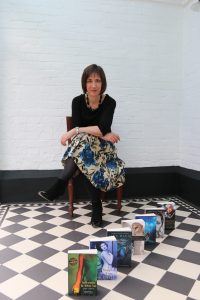
For readers who would like to know more about Jane Davis and her work, please see her website and/or follow her on Twitter, Facebook, and Pinterest.
Today, I’m delighted to welcome Elizabeth Gates to Virtual Book Club, my interview series which gives authors the opportunity to pitch their novels to your book club.
Between reading English Language & Literature at Bedford College, University of London, and acquiring an MA in Linguistics at the University of Essex, Elizabeth explored Europe as a teacher of English and Creative Writing. Later she worked as a freelance journalist – published for over twenty-five years, in national, regional and local magazines and newspapers, specialising in Public Health issues such as post-traumatic stress disorder in the armed forces and suicide among our farmers and the health of foreign seamen trapped on ships held in British ports. Elizabeth’s return to fiction has resulted in The Wolf of DalriadaStories. Her debut novel, The Wolf of Dalriada, was published in 2016 and the second in the series, Staining the Soul, will come out in 2018. A third and a fourth novel are already in the planning stage. Apart from writing, history and travel, she loves family, friends and labradors.
Q: Have you always felt driven to write or was there a particular trigger?
Writing is like breathing, for me. It’s not just a love of language. It’s a way of life, a way of viewing things – so much so that, growing up, I was surprised to find that other people didn’t want to write. When I discovered this, for a while I stopped saying I wanted to write. To say you wanted to be a writer at that time was almost like coming out at an Alcoholics Anonymous meeting. It was a shaming secret. I then met other writers and felt less of a freak. So yes, I’ve always been driven to write.
Q: ‘Notice how many of the Olympic athletes effusively thanked their mothers for their success? “She drove me to my practice at four in the morning,” etc. Writing is not figure skating or skiing. Your mother will not make you a writer. My advice to any young person who wants to write is: leave home.’ – Paul Theroux.
Well? Did You?
I did eventually – although I did write my first novel (about the Napoleonic Greek wars) instead of working for my Science ‘O’-levels. My mother supported me in that she gave my manuscript to the GP to read. His verdict: ‘She’s not mad. Just very, very creative!’ Not sure where that leaves me with relation to your question.
Q: What was your first recognition/success as an author?
On the 10th December 1985, I was contacted by a local theatre which wanted to put on a play I’d written about Judge Jefferys and, that very same day, an editor rang to say she wanted to publish an article I’d written on Dyslexia. Because life had become economically challenging at that point, I had to go with journalism – which I did for twenty-five years. However, nothing is wasted and my experience of writing about a 17th Century lawyer stood me in good stead for my return to historical fiction, decades later.

It is 1793… As Europe watches the French Revolution’s bloody progress, uneasy Scottish landowners struggle to secure their wealth and power. And, in Dalriada – the ancient Kingdom of Scotland – fractured truths, torn loyalties and bloody atrocities are rife. Can anyone ride the maelstrom of these dangerous times? Only, it seems, Malcolm Craig Lowrie – the legendary Wolf of Dalriada.
In remote Argyll, people cry out to the young laird for protection against the evil of the Clearances. And there is also a beautiful Frenchwoman – staked as a child on the turn of a card – now living in thrall to her debauched captor, Sir William Robinson. But can the Wolf of Dalriada safeguard his people? Can the Wolf defeat enemies who, like the spirit of Argyll’s Corryvrecken Whirlpool, threaten to engulf them all?
Q: Which brings me very neatly to your novel, The Wolf of Dalriada. The 18th Century seems ripe for picking, but what is it that fascinates you about that era?
!n 1793, the year in which The Wolf of Dalriada is set, the civilised world of Europe was awash with new ideas of social justice and social management. Some of these were good, and some bad, but old ideas – also some good and some bad – were hard to eradicate. In the midst of this kind of maelstrom, as ever, most people want to achieve ordinary human ambitions such as falling in love and living happily ever after. After all, even if you are bringing about the death of kings, you still need lunch. But everything at the time and in those places – post-Jacobite Scotland and Revolutionary Paris – was changing. All the old certainties were being challenged. Unthought of earlier, for instance, people were now choosing marrying for romantic reasons – not just for political alliance or commercial gain or personal aggrandisement – and the social consequences of this were tremendous. And there are of course so many stories to be told here.
I also find it fascinating the way human beings can work simultaneously with both basic impulses and grand ideas. The Wolf of Dalriada, for example, is a ‘modern man’ in 18th Century terms but he also represents of old Highland ways. In addition, there is also the suspicion that he may be one of the Celtic/Gaelic immortals. Certainly this is how he is seen by his clan. And the heroine, Adelaide de Fontenoy, brought up at Versailles, has to embrace disgrace and poverty and yet survive. The question is: can she? People of any era are endlessly complex and fascinating but I think that the people of the 18th Century were at times tested to destruction. A lesson for us all.
Q: One of the interesting things about writing historical fiction is that the reader has the benefit of hindsight, while the characters in the book do not. How do you use this to your advantage in The Wolf of Dalriada?
Given the complexity of the times, Characters have to second-guess the future – either to make sure they are on the winning side or to make a stand, while fearing the worst but hoping for the best. This lack of knowledge of what is certain, coupled with what the reader cannot help but know about history, ramps up suspense.
Q: Verbal anachronisms have been spotted in Downton Abbey and in Ripper Street. There’s always a difficulty of striking a balance between getting the ‘feel’ of the language of the era right and borrowing directly from the language of the day. How do you go about this?
Modern readers have been immersed for decades in period language and their passive knowledge – even if they don’t deploy the words and phrases – will surprise them. However, if only an 18th Scottish Gaelic word or French phrase will do – for information, setting or characterisation – then I feel context should make its meaning clear. If I use a word or phrase which seems anachronistic or too modern, during the edit, I use the Oxford University Press Dictionary to establish its origins and when it entered the language. (Some are surprisingly long-established.) And, if the word or phrase turns out to be inappropriate, I use a thesaurus to find any useful synonyms.
Q: The key trick in writing historical fiction is transporting readers to another time and place without overloading them with historical information. So how much detail is too much?
Whether it’s in the body of the prose or dialogue, the so-called information dump stands out like a sore thumb. It’s better by far to drip feed contextual details throughout a scene. I favour Hemingway’s view that research should be like an iceberg, only 10% visible. I always research to ensure accuracy but I don’t include everything I’ve learned because I’m not writing an historical academic essay. And I always bear in mind I’m building a world through this information to tell a story.

Q: Do you have a technique for keeping track of your fictional canvas and timeline?
Writing about characters’ lives against a known historical timeline brings its own subtleties. For example, in The Wolf of Dalriada, the significance of the execution of Marie Antoinette ripples outwards to embrace the Scottish Highlands weeks after the event. But, although she doesn’t know or understand why, the heroine is unable to escape the highlands and take a French ship because of a breakdown in French society which is already happening. In order to keep track of these causes and effects in both the characters’ fictional lives and the historic context of place and time I use the simplest of tools: a spreadsheet.
Q: I wonder, did you write about an event from the past that you felt was particularly relevant to the here and now? Or did you perhaps chose to write about an event that has since taken on relevance?
By 1793 – the period of The Wolf of Dalriada – Highland society had been largely re-organised in the aftermath of the 1745 Jacobite Rebellion. Pockets of resistance to the new wealth- and status-seeking aristocracy and bourgeoisie still existed but on the whole, the people most affected were disempowered. As one metaphor for this – illustrating clear parallels with today’s society’s changing values – the story of The Wolf of Dalriada explores what female characters must be prepared to do to find their path through life. Even today, when they have little control over societal change, people with virtually no voice have to rise to this sort of challenge! And, with varying success, they do.
Q: How has writing about history changed your perspective about history?
I am impressed more and more by how little people’s hopes have changed and how similar their responses and solutions to their problems are. This I feel is the great gift of historical study: that it offers lessons from which we can learn how to handle our current concerns.


One comment
Thank you so much for such an interesting experience, Jane. Incidentally, if there are any book club leaders out there who are thinking of adopting ‘The Wolf of Dalriada’, there is a list of suggested Book Club questions on my website.